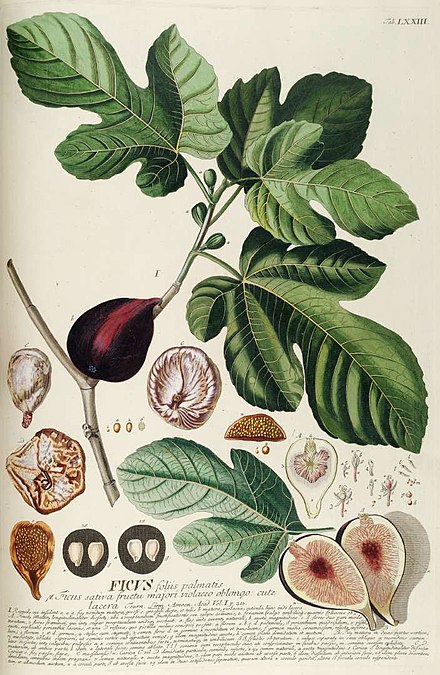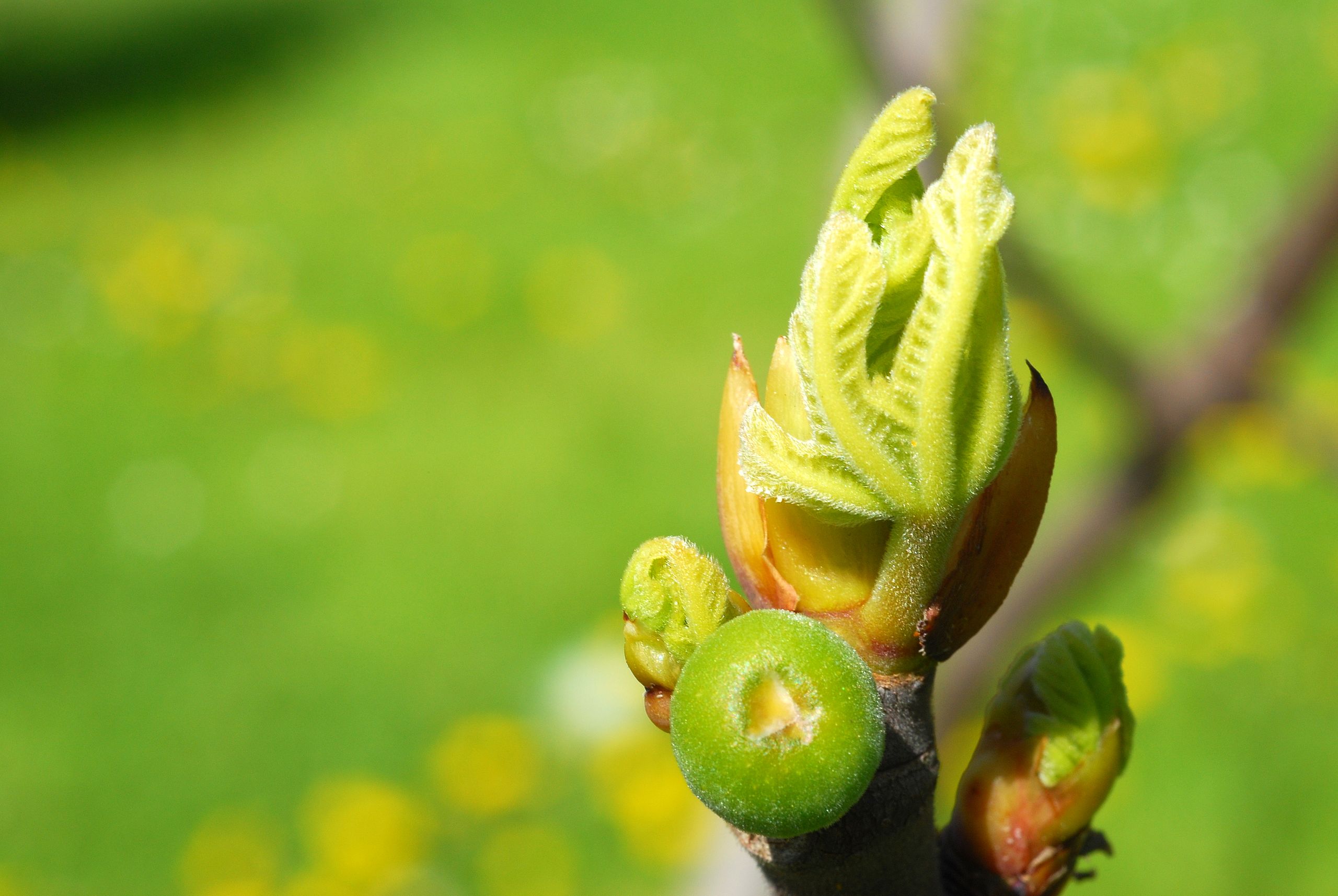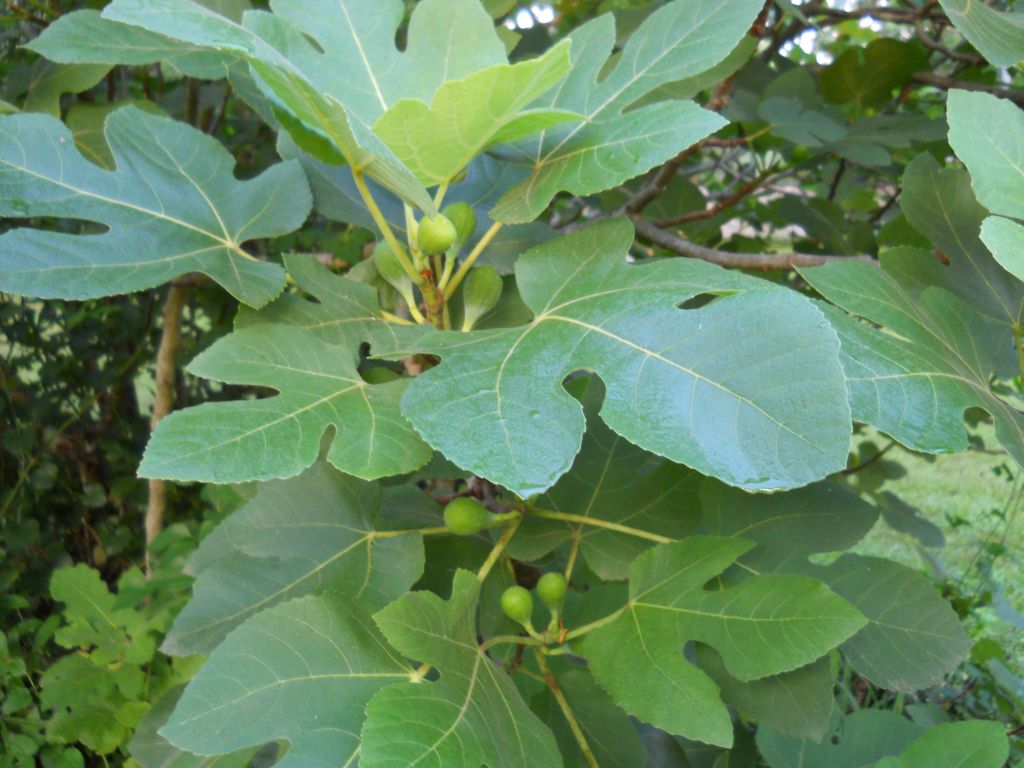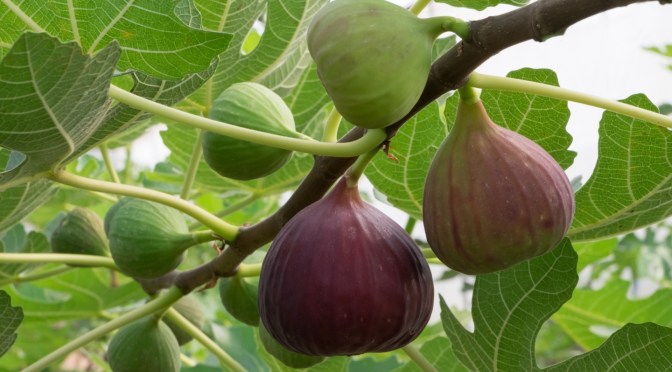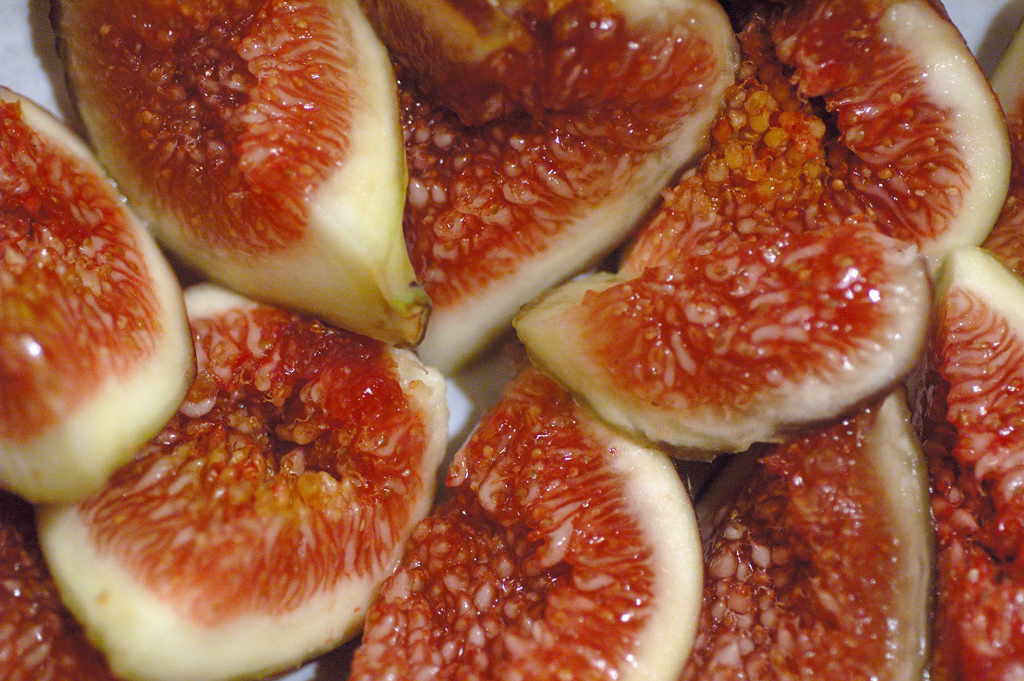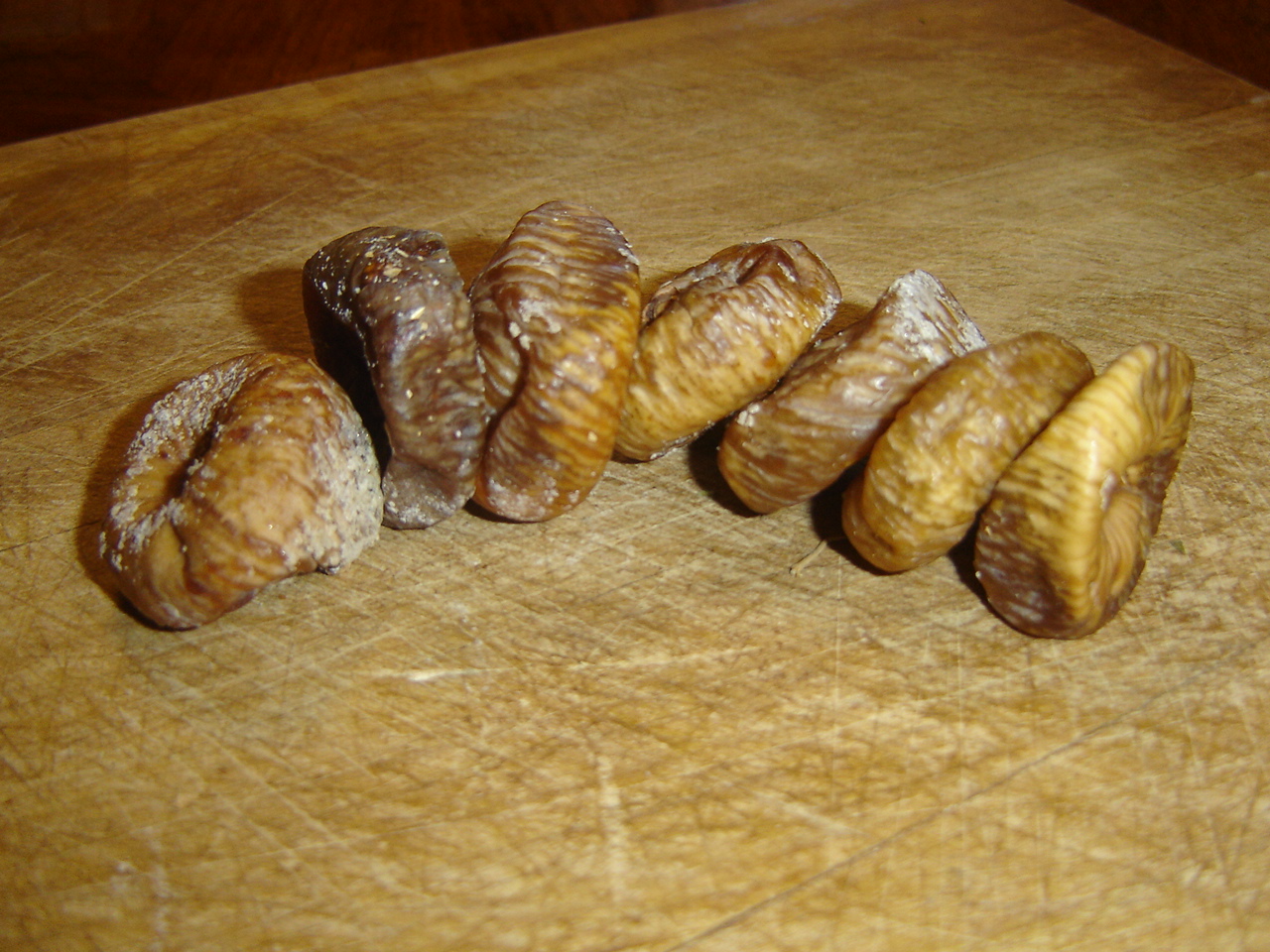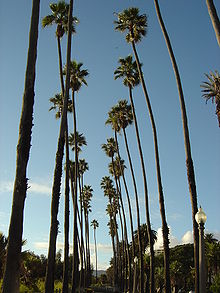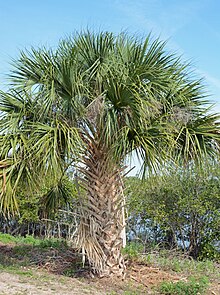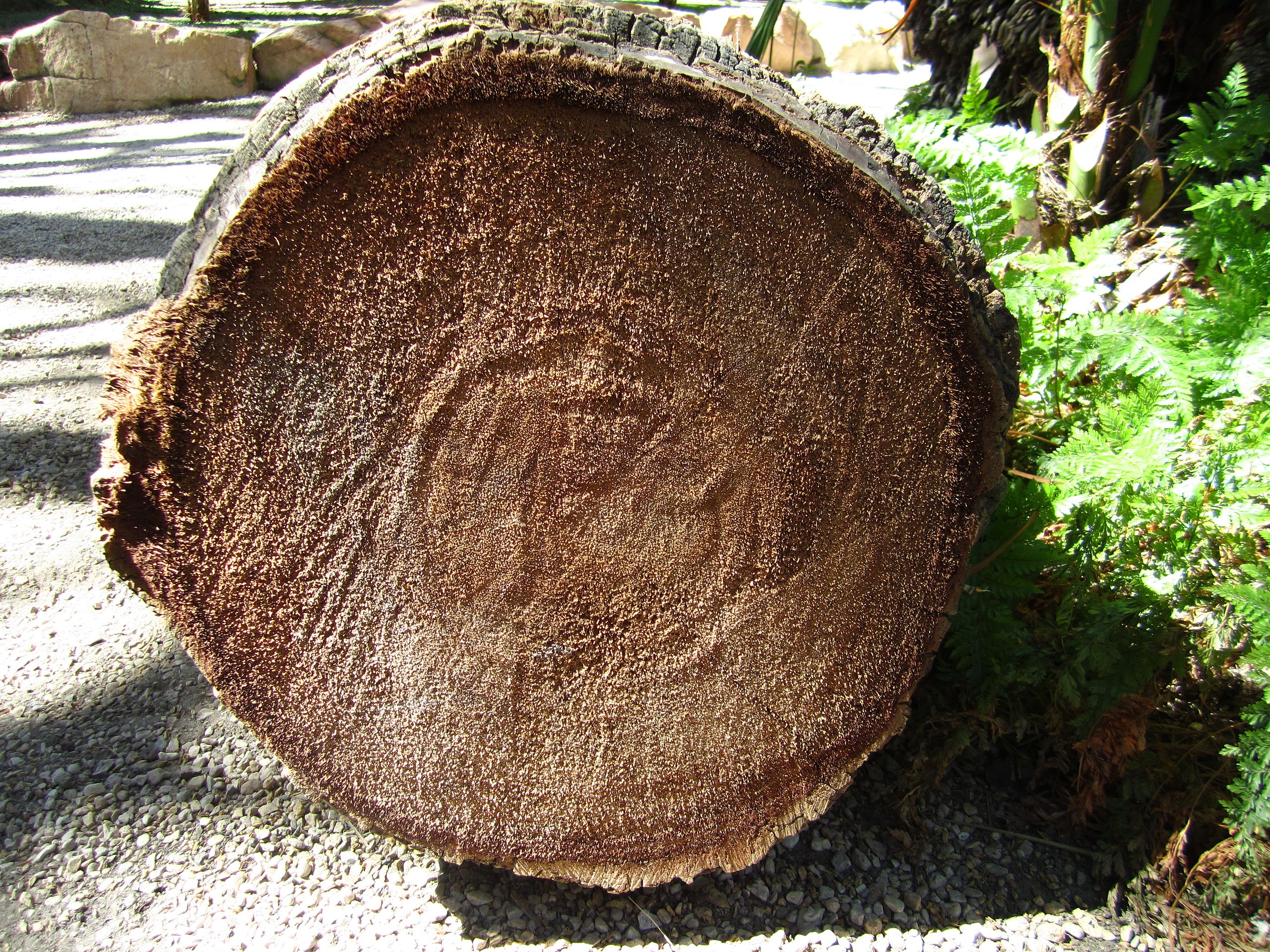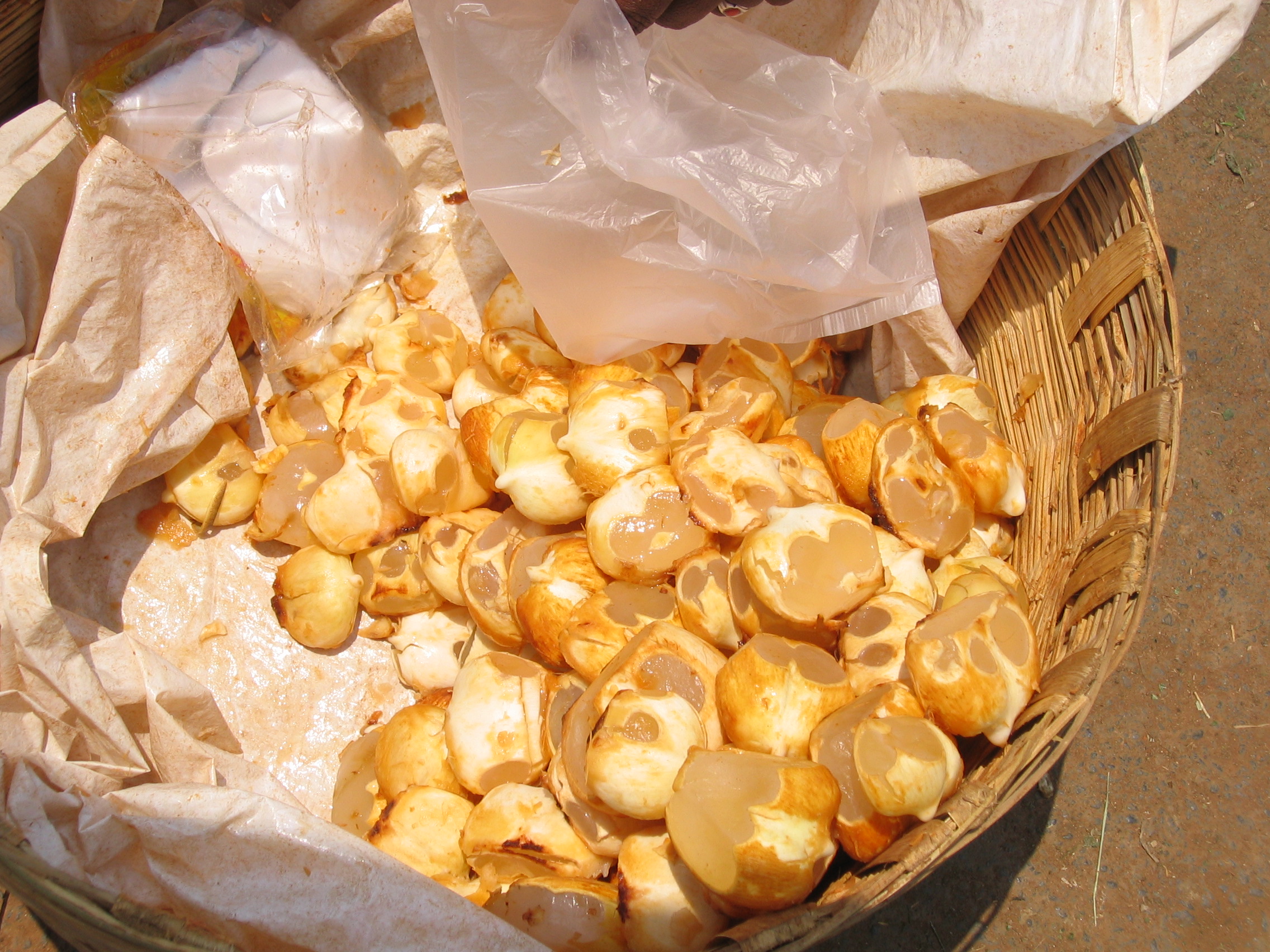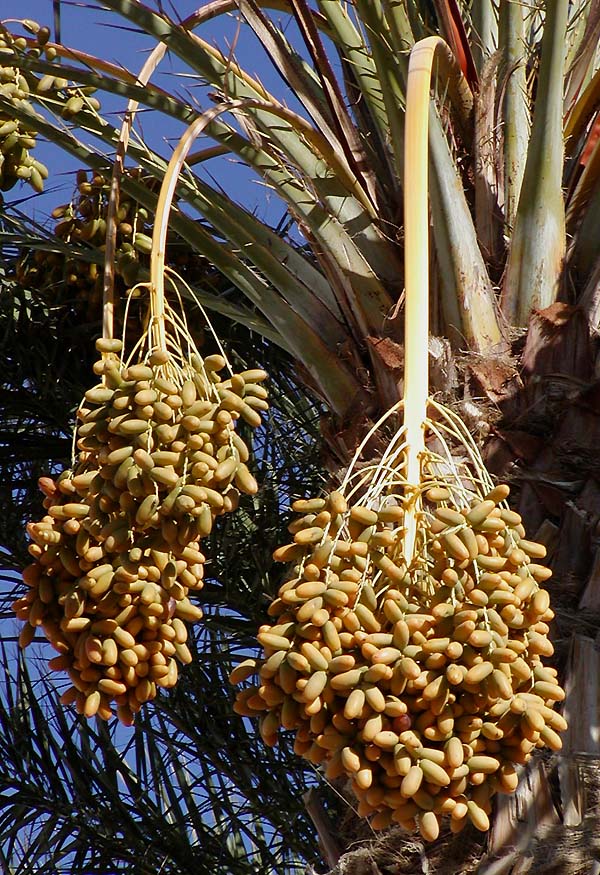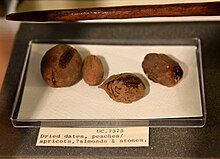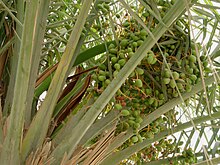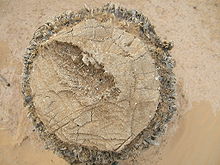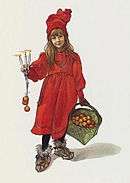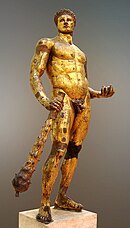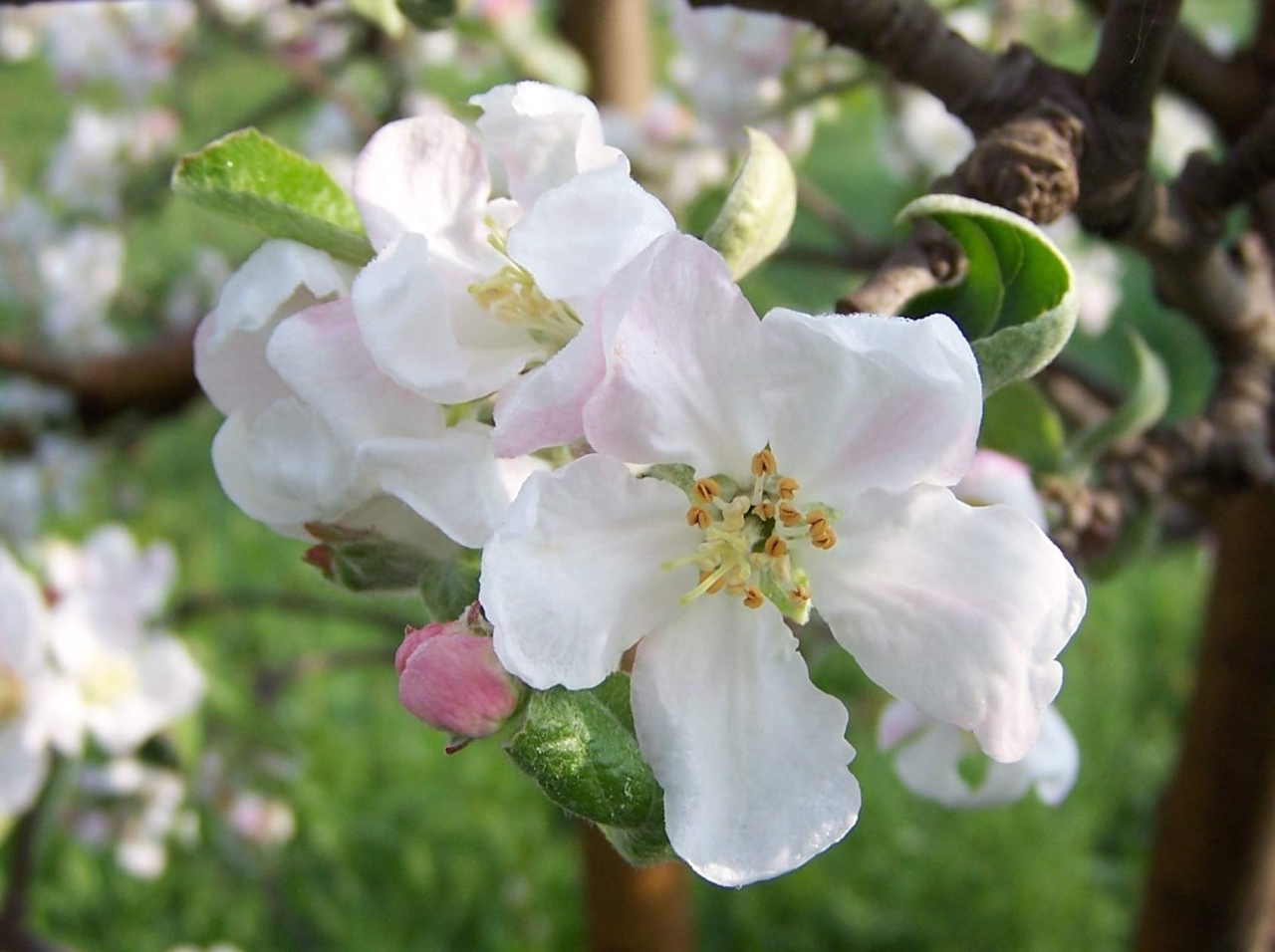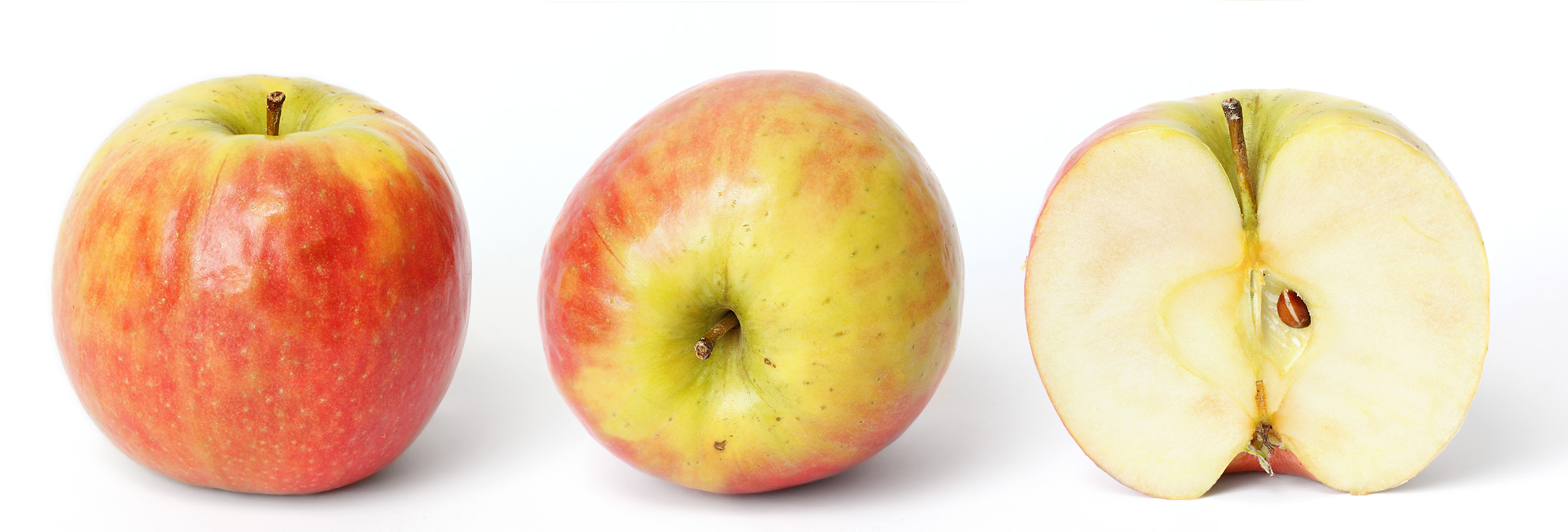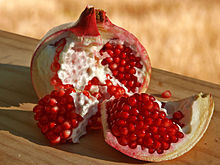Fruit Trees :: Olive :: Sycamore :: Fig :: (Date)Palm :: Apple :: Pomegranate
Fig
The term fig has its origins from the Latin word, ficus,
- as well as the older Hebrew name, feg.
The name of the caprifig (Ficus caprificus Risso) is derived from Latin,
- with capro referring to billygoat and ficus referring to fig.[8]
Ficus carica is a gynodioecious (functionally dioecious),[9]deciduoustree or large shrub, growing to a height of 7–10 metres (23–33 ft), with smooth white bark. Its fragrant leaves are 12–25 centimetres (4.7–9.8 in) long and 10–18 centimetres (3.9–7.1 in) across, and deeply lobed with three or five lobes. The complex inflorescence consists of a hollow fleshy structure called the syconium, which is lined with numerous unisexual flowers. The flowers themselves are not visible from outside the syconium, as they bloom inside the infructescence. Although commonly referred to as a fruit, the fig is actually the infructescence or scion of the tree, known as a false fruit or multiple fruit, in which the flowers and seeds are borne. It is a hollow-ended stem containing many flowers. The small orifice (ostiole) visible on the middle of the fruit is a narrow passage, which allows the specialized fig wasp Blastophaga psenes to enter the fruit and pollinate the flower, whereafter the fruit grows seeds. See Ficus: Fig fruit and reproduction system.
The edible fruit consists of the mature syconium containing numerous one-seeded fruits (druplets).[9] The fruit is 3–5 centimetres (1.2–2.0 in) long, with a green skin, sometimes ripening towards purple or brown. Ficus carica has milky sap (laticifer). The sap of the fig’s green parts is an irritant to human skin.[10]
[H8384] תְּאֵן tᵉʼên, teh-ane’; 39 in 35 the fig (tree or fruit):—fig (tree).
Genesis 3:
7 And the eyes of them both were opened, and they knew that they were naked; and they sewed fig[H8384] leaves together, and made themselves aprons.
Numbers 13:
23 And they came unto the brook of Eshcol, and cut down from thence a branch with one cluster of grapes, and they bare it between two upon a staff; and they brought of the pomegranates, and of the figs[H8384]
Numbers 20:
5 And wherefore have ye made us to come up out of Egypt, to bring us in unto this evil place? it is no place of seed, or of figs[H8384] or of vines, or of pomegranates; neither is there any water to drink.
Deuteronomy 8:
8 A land of wheat, and barley, and vines, and fig trees [H8384] and pomegranates; a land of oil olive, and honey;
Judges 9:
10 And the trees said to the fig tree [H8384] Come thou, and reign over us. 11 But the fig tree [H8384] said unto them, Should I forsake my sweetness, and my good fruit, and go to be promoted over the trees?
1 Kings 4:
25 And Judah and Israel dwelt safely, every man under his vine and under his fig tree [H8384] from Dan even to Beersheba, all the days of Solomon.
2 Kings 18:
31 Hearken not to Hezekiah: for thus saith the king of Assyria, Make an agreement with me by a present, and come out to me, and then eat ye every man of his own vine, and every one of his fig tree [H8384] and drink ye every one the waters of his cistern:
2 Kings 20:
7 And Isaiah said, Take a lump of figs[H8384] And they took and laid it on the boil, and he recovered.
Nehemiah 13:
15 In those days saw I in Judah some treading wine presses on the sabbath, and bringing in sheaves, and lading asses; as also wine, grapes, and figs [H8384] and all manner of burdens, which they brought into Jerusalem on the sabbath day: and I testified against them in the day wherein they sold victuals.
Psalm 105:
33 He smote their vines also and their fig trees [H8384] and brake the trees of their coasts.
Proverbs 27:
18 Whoso keepeth the fig tree [H8384] shall eat the fruit thereof: so he that waiteth on his master shall be honoured.
Song of Songs 2:
13 The fig tree [H8384] putteth forth her green figs, and the vines with the tender grape give a good smell. Arise, my love, my fair one, and come away.
Isaiah 34:
4 And all the host of heaven shall be dissolved, and the heavens shall be rolled together as a scroll: and all their host shall fall down, as the leaf falleth off from the vine, and as a falling fig from the fig tree [H8384]
Isaiah 36:
16 Hearken not to Hezekiah: for thus saith the king of Assyria, Make an agreement with me by a present, and come out to me: and eat ye every one of his vine, and every one of his fig tree [H8384] and drink ye every one the waters of his own cistern;
Isaiah 38:
21 For Isaiah had said, Let them take a lump of figs [H8384] and lay it for a plaister upon the boil, and he shall recover.
Jeremiah 5:
17 And they shall eat up thine harvest, and thy bread, which thy sons and thy daughters should eat: they shall eat up thy flocks and thine herds: they shall eat up thy vines and thy fig trees [H8384] they shall impoverish thy fenced cities, wherein thou trustedst, with the sword.
Jeremiah 8:
13 I will surely consume them, saith the LORD: there shall be no grapes on the vine, nor figs [H8384] on the fig tree [H8384]and the leaf shall fade; and the things that I have given them shall pass away from them.
Jeremiah 24:
1 The LORD shewed me, and, behold, two baskets of figs [H8384] were set before the temple of the LORD, after that Nebuchadrezzar king of Babylon had carried away captive Jeconiah the son of Jehoiakim king of Judah, and the princes of Judah, with the carpenters and smiths, from Jerusalem, and had brought them to Babylon. 2 One basket had very good figs [H8384] even like the figs [H8384] that are first ripe: and the other basket had very naughty figs [H8384] which could not be eaten, they were so bad. 3 Then said the LORD unto me, What seest thou, Jeremiah? And I said, figs [H8384] the good figs [H8384] very good; and the evil, very evil, that cannot be eaten, they are so evil. … 5 Thus saith the LORD, the God of Israel; Like these good figs [H8384] so will I acknowledge them that are carried away captive of Judah, whom I have sent out of this place into the land of the Chaldeans for their good. … 8 And as the evil figs [H8384] which cannot be eaten, they are so evil; surely thus saith the LORD, So will I give Zedekiah the king of Judah, and his princes, and the residue of Jerusalem, that remain in this land, and them that dwell in the land of Egypt:
Jeremiah 29:
17 Thus saith the LORD of hosts; Behold, I will send upon them the sword, the famine, and the pestilence, and will make them like vile figs [H8384] that cannot be eaten, they are so evil.
Hosea 2:
12 And I will destroy her vines and her fig trees [H8384] whereof she hath said, These are my rewards that my lovers have given me: and I will make them a forest, and the beasts of the field shall eat them.
Hosea 9:
10 I found Israel like grapes in the wilderness; I saw your fathers as the firstripe in the fig tree [H8384] at her first time: but they went to Baalpeor, and separated themselves unto that shame; and their abominations were according as they loved.
Joel 1:
7 He hath laid my vine waste, and barked my fig tree [H8384]he hath made it clean bare, and cast it away; the branches thereof are made white. … 12 The vine is dried up, and the fig tree [H8384] languisheth; the pomegranate tree, the palm tree also, and the apple tree, even all the trees of the field, are withered: because joy is withered away from the sons of men.
Joel 2:
22 Be not afraid, ye beasts of the field: for the pastures of the wilderness do spring, for the tree beareth her fruit, the fig tree [H8384] and the vine do yield their strength.
Amos 4:
9 I have smitten you with blasting and mildew: when your gardens and your vineyards and your fig trees [H8384] and your olive trees increased, the palmerworm devoured them: yet have ye not returned unto me, saith the LORD.
Micah 4:
4 But they shall sit every man under his vine and under his fig tree [H8384] and none shall make them afraid: for the mouth of the LORD of hosts hath spoken it.
Nahum 3:
12 All thy strong holds shall be like fig trees [H8384] with the firstripe figs: if they be shaken, they shall even fall into the mouth of the eater.
Habakkuk 3:
17 Although the fig tree [H8384]shall not blossom, neither shall fruit be in the vines; the labour of the olive shall fail, and the fields shall yield no meat; the flock shall be cut off from the fold, and there shall be no herd in the stalls:
Haggai 2:
19 Is the seed yet in the barn? yea, as yet the vine, and the fig tree [H8384] and the pomegranate, and the olive tree, hath not brought forth: from this day will I bless you.
Zechariah 3:
10 In that day, saith the LORD of hosts, shall ye call every man his neighbour under the vine and under the fig tree [H8384]
[G4810] σῦκον sŷkon, soo’-kon; 4 in 4 a fig:—fig.
Matthew 7:
16 Ye shall know them by their fruits. Do men gather grapes of thorns, or figs[G4810] of thistles?
Mark 11:
13 And seeing a fig tree afar off having leaves, he came, if haply he might find any thing thereon: and when he came to it, he found nothing but leaves; for the time of figs[G4810] was not yet.
Luke 6:
44 For every tree is known by his own fruit. For of thorns men do not gather figs,[G4810] nor of a bramble bush gather they grapes.
James 3:
12 Can the fig tree, my brethren, bear olive berries? either a vine, figs?[G4810] so can no fountain both yield salt water and fresh.
from G4810;
[G4808] συκῆ sykē, soo-kay’; 16 in 15 a fig-tree:—fig tree.
Matthew 21:
19 And when he saw a fig tree[G4808] in the way, he came to it, and found nothing thereon, but leaves only, and said unto it, Let no fruit grow on thee henceforward for ever. And presently the fig tree[G4808] withered away. 20 And when the disciples saw it, they marvelled, saying, How soon is the fig tree[G4808] withered away! 21 Jesus answered and said unto them, Verily I say unto you, If ye have faith, and doubt not, ye shall not only do this which is done to the fig tree,[G4808] but also if ye shall say unto this mountain, Be thou removed, and be thou cast into the sea; it shall be done.
Matthew 24:
32 Now learn a parable of the fig tree;[G4808] When his branch is yet tender, and putteth forth leaves, ye know that summer is nigh:
Mark 11:
13 And seeing a fig tree[G4808] afar off having leaves, he came, if haply he might find any thing thereon: and when he came to it, he found nothing but leaves; for the time of figs was not yet. … 20 And in the morning, as they passed by, they saw the fig tree[G4808] dried up from the roots. 21 And Peter calling to remembrance saith unto him, Master, behold, the fig tree[G4808] which thou cursedst is withered away.
Mark 13:
28 Now learn a parable of the fig tree;[G4808] When her branch is yet tender, and putteth forth leaves, ye know that summer is near:
Luke 13:
6 He spake also this parable; A certain man had a fig tree[G4808] planted in his vineyard; and he came and sought fruit thereon, and found none. 7 Then said he unto the dresser of his vineyard, Behold, these three years I come seeking fruit on this fig tree,[G4808] and find none: cut it down; why cumbereth it the ground?
Luke 21
29 And he spake to them a parable; Behold the fig tree,[G4808] and all the trees;
John 1:
48 Nathanael saith unto him, Whence knowest thou me? Jesus answered and said unto him, Before that Philip called thee, when thou wast under the fig tree,[G4808] I saw thee. … 50 Jesus answered and said unto him, Because I said unto thee, I saw thee under the fig tree,[G4808] believest thou? thou shalt see greater things than these.
James 3:
12 Can the fig tree,[G4808] my brethren, bear olive berries? either a vine, figs? so can no fountain both yield salt water and fresh.
Revelation 6:
13 And the stars of heaven fell unto the earth, even as a fig tree[G4808] casteth her untimely figs, when she is shaken of a mighty wind.
[G3653] ὄλυνθος ólynthos, ol’-oon-thos; 1 in 1 an unripe (because out of season) fig:—untimely fig.
- an unripe fig which grows during the winter, yet does not come to maturity but falls off in the spring
Revelation 6:
13 And the stars of heaven fell unto the earth, even as a fig tree casteth her untimely figs,[G3653] when she is shaken of a mighty wind.
[H7416] רִמּוֹן rimmôwn, rim-mone’; or רִמֹּן rimmôn; 32 in 25 pomegranate (tree)
- a pomegranate,
- the tree (from its upright growth)
- or the fruit (also an artificial ornament):—pomegranate.
Exodus 28:33-34 KJV – 33 And beneath upon the hem of it thou shalt make pomegranates[H7416] of blue, and of purple, and of scarlet, round about the hem thereof; and bells of gold between them round about: 34 A golden bell and a pomegranate,[H7416] a golden bell and a pomegranate,[H7416] upon the hem of the robe round about.
Exodus 39:24-26 KJV – 24 And they made upon the hems of the robe pomegranates[H7416] of blue, and purple, and scarlet, and twined linen. 25 And they made bells of pure gold, and put the bells between the pomegranates[H7416] upon the hem of the robe, round about between the pomegranates;[H7416] 26 A bell and a pomegranate,[H7416] a bell and a pomegranate,[H7416] round about the hem of the robe to minister in; as the LORD commanded Moses.
Numbers 13:23 KJV – 23 And they came unto the brook of Eshcol, and cut down from thence a branch with one cluster of grapes, and they bare it between two upon a staff; and they brought of the pomegranates,[H7416] and of the figs.
Numbers 20:5 KJV – 5 And wherefore have ye made us to come up out of Egypt, to bring us in unto this evil place? it is no place of seed, or of figs, or of vines, or of pomegranates;[H7416] neither is there any water to drink.
Deuteronomy 8:8 KJV – 8 A land of wheat, and barley, and vines, and fig trees, and pomegranates;[H7416] a land of oil olive, and honey;
1 Samuel 14:2 KJV – 2 And Saul tarried in the uttermost part of Gibeah under a pomegranate tree[H7416] which is in Migron: and the people that were with him were about six hundred men;
1 Kings 7:18, 20, 42 KJV – 18 And he made the pillars, and two rows round about upon the one network, to cover the chapiters that were upon the top, with pomegranates:[H7416] and so did he for the other chapiter. … 20 And the chapiters upon the two pillars had pomegranates also above, over against the belly which was by the network: and the pomegranates[H7416] were two hundred in rows round about upon the other chapiter. … 42 And four hundred pomegranates[H7416] for the two networks, even two rows of pomegranates[H7416] for one network, to cover the two bowls of the chapiters that were upon the pillars;
2 Kings 25:17 KJV – 17 The height of the one pillar was eighteen cubits, and the chapiter upon it was brass: and the height of the chapiter three cubits; and the wreathen work, and pomegranates[H7416] upon the chapiter round about, all of brass: and like unto these had the second pillar with wreathen work.
2 Chronicles 3:16 KJV – 16 And he made chains, as in the oracle, and put them on the heads of the pillars; and made an hundred pomegranates,[H7416] and put them on the chains.
2 Chronicles 4:13 KJV – 13 And four hundred pomegranates[H7416] on the two wreaths; two rows of pomegranates[H7416] on each wreath, to cover the two pommels of the chapiters which were upon the pillars.
Song of Songs 4:3, 13 KJV – 3 Thy lips are like a thread of scarlet, and thy speech is comely: thy temples are like a piece of a pomegranate[H7416] within thy locks. … 13 Thy plants are an orchard of pomegranates,[H7416] with pleasant fruits; camphire, with spikenard,
Song of Songs 6:7, 11 KJV – 7 As a piece of a pomegranate[H7416] are thy temples within thy locks. … 11 I went down into the garden of nuts to see the fruits of the valley, and to see whether the vine flourished, and the pomegranates[H7416] budded.
Song of Songs 7:12 KJV – 12 Let us get up early to the vineyards; let us see if the vine flourish, whether the tender grape appear, and the pomegranates[H7416] bud forth: there will I give thee my loves.
Song of Songs 8:2 KJV – 2 I would lead thee, and bring thee into my mother’s house, who would instruct me: I would cause thee to drink of spiced wine of the juice of my pomegranate.[H7416]
Jeremiah 52:22-23 KJV – 22 And a chapiter of brass was upon it; and the height of one chapiter was five cubits, with network and pomegranates[H7416] upon the chapiters round about, all of brass. The second pillar also and the pomegranates[H7416] were like unto these. 23 And there were ninety and six pomegranates[H7416] on a side; and all the pomegranates[H7416] upon the network were an hundred round about.
Joel 1:12 KJV – 12 The vine is dried up, and the fig tree languisheth; the pomegranate[H7416] tree, the palm tree also, and the apple tree, even all the trees of the field, are withered: because joy is withered away from the sons of men.
Haggai 2:19 KJV – 19 Is the seed yet in the barn? yea, as yet the vine, and the fig tree, and the pomegranate,[H7416] and the olive tree, hath not brought forth: from this day will I bless you.
from H7426;
- רָמַם râmam, raw-mam’; 7x to rise
- (literally or figuratively):
- —exalt, get (oneself) up, lift up (self), mount up
Numbers 16:
45 Get you up[H7426] from among this congregation, that I may consume them as in a moment. And they fell upon their faces.
Job 24:
24 They are exalted[H7426] for a little while, but are gone and brought low; they are taken out of the way as all other, and cut off as the tops of the ears of corn.
Psalm 118:
16 The right hand of the LORD is exalted:[H7426] the right hand of the LORD doeth valiantly.
Isaiah 33:
10 Now will I rise, saith the LORD; now will I be exalted;[H7426] now will I lift up myself.
Ezekiel 10:
15 And the cherubims were lifted up.[H7426] This is the living creature that I saw by the river of Chebar. … 17 When they stood, these stood; and when they were lifted up, these lifted up[H7426] themselves also: for the spirit of the living creature was in them. … 19 And the cherubims lifted up their wings, and mounted up[H7426] from the earth in my sight: when they went out, the wheels also were beside them, and every one stood at the door of the east gate of the LORD’S house; and the glory of the God of Israel was over them above.
Sycamore Tree
Ficus sycomorus, called the sycamore fig or the fig-mul
berry (because the leaves resemble those of the mulberry), sycamore, or sycomore, is a fig species that has been cultivated since ancient times.
The term sycamore spelled with an A has also been used for unrelated trees: the Great Maple, Acer pseudoplatanus, or plane trees, Platanus. The spelling “sycomore”, with an O rather than an A as the second vowel is, if used, specific to Ficus sycomorus .[1][2]
Ficus sycomorus is native to Africa south of the Sahel and north of the Tropic of Capricorn, also excluding the central-west rainforest areas. It also grows naturally in Lebanon, whose famous Gemmayzeh Street is derived from the tree’s Arabic name, Gemmayz; in the southern Arabian Peninsula; in Cyprus; in very localized areas in Madagascar; and as a naturalised species in Israeland Egypt. In its native habitat, the tree is usually found in rich soils along rivers and in mixed woodlands.
Ficus sycomorus grows to 20 m tall and has a considerable spread as can be seen from the photograph below left, with a dense round crown of spreading branches[clarification needed]. The leavesare heart-shaped with a round apex, 14 cm long by 10 cm wide, and arranged spirally around the twig. They are dark green above and lighter with prominent yellow veins below, and both surfaces are rough to the touch. The petiole is 0.5–3 cm long and pubescent. The fruit is a large edible fig, 2–3 cm in diameter, ripening from buff-green to yellow or red. They are borne in thick clusters on long branchlets or the leaf axil. Flowering and fruiting occurs year-round, peaking from July to December. The bark is green-yellow to orange and exfoliates in papery strips to reveal the yellow inner bark. Like all other figs, it contains a latex.
According to botanists Daniel Zohary (b. 1926) and Maria Hopf (1914–2008),[citation needed] the ancient Egyptians cultivated this species “almost exclusively.”[clarification needed] Remains of F. sycomorus begin to appear in predynastic levels and in quantity from the start of the third millennium BC.
It was the ancient Egyptian Tree of Life.[3] Zohary and Hopf note that “the fruit and the timber, and sometimes even the twigs, are richly represented in the tombs of the Egyptian Early, Middle and Late Kingdoms.” In numerous cases the parched fruiting bodies, known as sycons, “bear characteristic gashing marks indicating that this art, which induces ripening, was practised in Egypt in ancient times.”[4]
Although this species of fig requires the presence of the symbioticwaspCeratosolen arabicus to reproduce sexually, and this insect is extinct in Egypt, Zohay and Hopf have no doubt that Egypt was “the principal area of sycamore fig development.”[clarification needed] Some of the caskets of mummies in Egypt are made from the wood of this tree. In tropical areas where the wasp is common, complex mini-ecosystems involving the wasp, nematodes, other parasitic wasps, and various larger predators revolve around the life cycle of the fig. The trees’ random production of fruit in such environments assures its constant attendance by the insects and animals which form this ecosystem.
A study in 2015 indicated that the sycamore tree was brought to Israel by Philistines during the Iron Age, along with opium poppy and cumin.[5][6]
the sycomore was a very popular and valuable fruit tree in Jericho and Canaan.[7]
The Egyptians’ Holy Sycamore also stood on the threshold of life and death, connecting the two worlds.
To the Ancient Egyptians, the Tree of Life represented the hierarchical chain of events that brought everything into existence. The spheres of the Tree of Life demonstrate the order, process, and method of creation.
In Egyptian mythology, in the Ennead system of Heliopolis, the first couple, apart from Shu and Tefnut (moisture and dryness) and Geb and Nut (earth and sky), are Isis and Osiris.
They were said to have emerged from the acacia tree of Iusaaset, which the Egyptians considered the tree of life, referring to it as the “tree in which life and death are enclosed”.
A much later myth relates how Set and 72 conspirators killed Osiris, putting him in a coffin, and throwing it into the Nile, the coffin becoming embedded in the base of a tamarisk tree.[7]
They are evergreen or deciduous shrubs or trees growing to 1–18 m in height and forming dense thickets. The largest, Tamarix aphylla, is an evergreen tree that can grow to 18 m tall. They usually grow on saline soils, tolerating up to 15,000 ppm soluble salt and can also tolerate alkaline conditions.
Tamarisks are characterized by slender branches and grey-green foliage. The bark of young branches is smooth and reddish brown. As the plants age, the bark becomes bluish-purple, ridged and furrowed.
The leaves are scale-like, almost like that of junipers [4] 1–2 mm long, and overlap each other along the stem. They are often encrusted with salt secretions.
The pink to white flowers appear in dense masses on 5–10 cm long spikes at branch tips from March to September, though some species (e.g. T. aphylla) tend to flower during the winter.
In the Epic of Gilgamesh, Gilgamesh’s mother, the goddess Ninsun, ceremoniously bathes in a bath of “tamarisk” and soapwort before allowing Gilgamesh and Enkidu to begin their conquest.
In Genesis 21:33, Abraham is recorded to have “planted a tamarisk at Beer-sheba”.[33] He had built a well there, earlier.
In 1 Samuel 22:6, Saul is sitting under a tamarisk tree on a hill at Gibeah when he learns that David has returned to Judah.[34]
In Shahnameh, only a tamarisk arrow to the eye can wound the otherwise invincible Prince Esfandiar.
In the Quran 34:16, the people of Saba were punished when “[Allah] converted their two garden (rows) into gardens producing bitter fruit and tamarisks…”.
In the Old Testament, Saul’s bones are buried under a tamarisk tree in Jabesh.
In Egyptian mythology, the body of Osiris is hidden for a time in a tamarisk tree in Byblos, until it was retrieved by Isis. A reference to this is also made in the computer game, Age of Mythology, in which the head of Osiris is said to be hidden inside the trunk of a great tamarisk tree.
Wedgwood made a “Tamarisk” China pattern.
The genus Tamarix (tamarisk, salt cedar) is composed of about 50–60 species of flowering plants in the family Tamaricaceae, native to drier areas of Eurasia and Africa.[2] The generic name originated in Latin and may refer to the Tamaris River in Hispania Tarraconensis (Spain).[3]
[H815] אֵשֶׁל ʼêshel, ay’-shel; 3x a tamarisk tree;
- from a root of uncertain signification;
- by extension,
- a grove of any kind:—grove, tree.
Genesis 21:
(33) And [Abraham] planted a grove[H815] in Beersheba, and called there on the name of the LORD, the everlasting God.
1 Samuel 22:
(6) When Saul heard that David was discovered, and the men that [were] with him, (now Saul abode in Gibeah under a tree[H815] in Ramah, having his spear in his hand, and all his servants [were] standing about him;)
1 Samuel 31:
(13) And they took their bones, and buried [them] under a tree[H815]at Jabesh, and fasted seven days.
[h8256] שִׁקְמָה shiqmâh, shik-maw’; 7x a sycamore (tree/fruit)
- resembles fruit of fig tree but more difficult to digest
- only cultivated by the person of the lowest degree
1 Kings 10:
27 And the king made silver to be in Jerusalem as stones,
and cedars made he to be as the sycomore trees[H8256] that are in the vale, for abundance.
1 Chronicles 27:
28 And over the olive trees and the sycomore trees[H8256]
that were in the low plains was Baalhanan the Gederite:
and over the cellars of oil was Joash:
2 Chronicles 1:
15 And the king made silver and gold at Jerusalem as plenteous as stones,
and cedar trees made he as the sycomore trees[H8256] that are in the vale for abundance.
2 Chronicles 9:
27 And the king made silver in Jerusalem as stones,
and cedar trees made he as the sycomore trees[H8256] that are in the low plains in abundance.
Psalm 78:
47 He destroyed their vines with hail, and their sycomore trees[H8256] with frost.
Isaiah 9:
10 The bricks are fallen down, but we will build with hewn stones:
the sycomore [H8256] are cut down, but we will change them into cedars.
Amos 7:
14 Then answered Amos, and said to Amaziah,
I was no prophet, neither was I a prophet’s son;
but I was an herdman, and a gatherer of sycomore fruit:[H8256]
[G4809] †συκομωραία sykomōraía, soo-kom-o-rah’-yah; 1x the “sycamore”-fig tree:
Luke 19:
(4) And he ran before, and climbed up into a sycomore tree[G4809] to see him: for he was to pass that [way].
The Arecaceae are a botanical family of perennial climbers, shrubs, acaules and trees commonly known as palm trees (owing to historical usage, the family is alternatively called Palmae).[3] They are flowering plants, a family in the monocot order Arecales. Currently 181 genera with around 2600 species are known,[4] most of them restricted to tropical and subtropical climates. Most palms are distinguished by their large, compound, evergreen leaves, known as fronds, arranged at the top of an unbranched stem. However, palms exhibit an enormous diversity in physical characteristics and inhabit nearly every type of habitat within their range, from rainforests to deserts.
Palms are among the best known and most extensively cultivated plant families. They have been important to humans throughout much of history. Many common products and foods are derived from palms, and palms are also widely used in landscaping, making them one of the most economically important plants. In many historical cultures, palms were symbols for such ideas as victory, peace, and fertility. For inhabitants of cooler climates today, palms symbolize the tropics and vacations.[5]
Morphology[edit]
Whether as shrubs, trees, or vines, palms have two methods of growth: solitary or clustered. The common representation is that of a solitary shoot ending in a crown of leaves. This monopodialcharacter may be exhibited by prostrate, trunkless, and trunk-forming members. Some common palms restricted to solitary growth include Washingtonia and Roystonea. Palms may instead grow in sparse though dense clusters. The trunk develops an axillary bud at a leaf node, usually near the base, from which a new shoot emerges. The new shoot, in turn, produces an axillary bud and a clustering habit results. Exclusively sympodial genera include many of the rattans, Guihaia, and Rhapis. Several palm genera have both solitary and clustering members. Palms which are usually solitary may grow in clusters, and vice versa. These aberrations suggest the habit operates on a single gene.[6]
Palms have large, evergreen leaves that are either palmately (‘fan-leaved’) or pinnately (‘feather-leaved’) compound and spirally arranged at the top of the stem. The leaves have a tubular sheath at the base that usually splits open on one side at maturity.[7] The inflorescence is a spadix or spike surrounded by one or more bracts or spathes that become woody at maturity. The flowers are generally small and white, radially symmetric, and can be either uni- or bisexual. The sepals and petals usually number three each, and may be distinct or joined at the base. The stamens generally number six, with filaments that may be separate, attached to each other, or attached to the pistil at the base. The fruit is usually a single-seeded drupe (sometimes berry-like)[8] but some genera (e.g. Salacca) may contain two or more seeds in each fruit.
Like all monocots, palms do not have the ability to increase the width of a stem (secondary growth) via the same kind of vascular cambium found in non-monocot woody plants.[9] This explains the cylindrical shape of the trunk (almost constant diameter) that is often seen in palms, unlike in true trees. However, many palms, like some other monocots, do have secondary growth, although because it does not arise from a single vascular cambium producing xylem inwards and phloem outwards, it is often called “anomalous secondary growth”.[10]
The Arecaceae are notable among monocots for their height and for the size of their seeds, leaves, and inflorescences. Ceroxylon quindiuense, Colombia‘s national tree, is the tallest monocot in the world, reaching up to 60 m tall.[11] The coco de mer (Lodoicea maldivica) has the largest seeds of any plant, 40–50 cm in diameter and weighing 15–30 kg each. Raffia palms (Raphia spp.) have the largest leaves of any plant, up to 25 m long and 3 m wide. The Corypha species have the largest inflorescence of any plant, up to 7.5 m tall and containing millions of small flowers. Calamus stems can reach 200 m in length.
Range and habitat[edit]
Most palms are native to tropical and subtropical climates. Palms thrive in moist and hot climates but can be found in a variety of different habitats. Their diversity is highest in wet, lowland forests. South America, the Caribbean, and areas of the south Pacific and southern Asia are regions of concentration. Colombia may have the highest number of palm species in one country. There are some palms that are also native to desert areas such as the Arabian peninsula and parts of northwestern Mexico. Only about 130 palm species naturally grow entirely beyond the tropics, mostly in humid lowland subtropical climates, in highlands in southern Asia, and along the rim lands of the Mediterranean Sea. The northernmost native palm is Chamaerops humilis, which reaches 44°N latitude in along the coast of southern France.[12] In the southern hemisphere, the southernmost palm is the Rhopalostylis sapida, which reaches 44°S on the Chatham Islands where an oceanic climate prevails.[12] Cultivation of palms is possible north of subtropical climates, and some higher latitude locals such as Ireland, Scotland, England, and the Pacific Northwest feature a few palms in protected locations.
Palms inhabit a variety of ecosystems. More than two-thirds of palm species live in humid moist forests, where some species grow tall enough to form part of the canopy and shorter ones form part of the understory.[13] Some species form pure stands in areas with poor drainage or regular flooding, including Raphia hookeri which is common in coastal freshwater swamps in West Africa. Other palms live in tropical mountain habitats above 1000 m, such as those in the genus Ceroxylon native to the Andes. Palms may also live in grasslands and scrublands, usually associated with a water source, and in desert oases such as the date palm. A few palms are adapted to extremely basic lime soils, while others are similarly adapted to extreme potassium deficiency and toxicity of heavy metals in serpentine soils.[12]
Two Roystonea regia specimens in Kolkata, India, note the characteristic crownshaft and apex shoot or ‘spear’
Palms are a monophyletic group of plants, meaning the group consists of a common ancestor and all its descendants.[13] Extensive taxonomic research on palms began with botanist H.E. Moore, who organized palms into 15 major groups based mostly on general morphological characteristics. The following classification, proposed by N.W. Uhl and J. Dransfield in 1987, is a revision of Moore’s classification that organizes palms into six subfamilies.[14]
A few general traits of each subfamily are listed below.
The Coryphoideae are the most diverse subfamily, and are a paraphyletic group, meaning all members of the group share a common ancestor, but the group does not include all the ancestor’s descendants. Most palms in this subfamily have palmately lobed leaves and solitary flowers with three, or sometimes four carpels. The fruit normally develops from only one carpel.
Subfamily Calamoideae includes the climbing palms, such as rattans. The leaves are usually pinnate; derived characters (synapomorphies) include spines on various organs, organs specialized for climbing, an extension of the main stem of the leaf-bearing reflexed spines, and overlapping scales covering the fruit and ovary.
Subfamily Nypoideae contains only one species, Nypa fruticans,[15] which has large, pinnate leaves. The fruit is unusual in that it floats, and the stem is dichotomously branched, also unusual in palms.
Subfamily Ceroxyloideae has small to medium-sized flowers, spirally arranged, with a gynoecium of three joined carpels.
The Arecoideae are the largest subfamily, with six diverse tribes (Areceae, Caryoteae, Cocoeae, Geonomeae, Iriarteeae, and Podococceae) containing over 100 genera. All tribes have pinnate or bipinnate leaves and flowers arranged in groups of three, with a central pistillate and two staminate flowers.
The Phytelephantoideae are a monoecious subfamily. Members of this group have distinct monopodial flower clusters. Other distinct features include a gynoecium with five to 10 joined carpels, and flowers with more than three parts per whorl. Fruits are multiple-seeded and have multiple parts.[16]
Currently, few extensive phylogenetic studies of the Arecaceae exist. In 1997, Baker et al. explored subfamily and tribe relationships using chloroplast DNA from 60 genera from all subfamilies and tribes. The results strongly showed the Calamoideae are monophyletic, and Ceroxyloideae and Coryphoideae are paraphyletic. The relationships of Arecoideae are uncertain, but they are possibly related to the Ceroxyloideae and Phytelephantoideae. Studies have suggested the lack of a fully resolved hypothesis for the relationships within the family is due to a variety of factors, including difficulties in selecting appropriate outgroups, homoplasy in morphological character states, slow rates of molecular evolution important for the use of standard DNA markers, and character polarization.[17] However, hybridization has been observed among Orbignya and Phoenix species, and using chloroplast DNA in cladistic studies may produce inaccurate results due to maternal inheritance of the chloroplast DNA. Chemical and molecular data from non-organelle DNA, for example, could be more effective for studying palm phylogeny.[16]
Evolution[edit]
The Arecaceae are the first modern family of monocots appearing in the fossil record[citation needed] around 80 million years ago (Mya), during the late Cretaceous period. The first modern species, such as Nypa fruticans and Acrocomia aculeata, appeared 94 Mya, confirmed by fossil Nypa pollen dated to 94 Mya.[clarification needed] Palms appear to have undergone an early period of adaptive radiation.[citation needed] By 60 Mya, many of the modern, specialized genera of palms appeared and became widespread and common, much more widespread than their range today.[citation needed]Because palms separated from the monocots earlier than other families,[when?] they developed more intrafamilial specialization and diversity.[citation needed][clarification needed] By tracing back these diverse characteristics of palms to the basic structures of monocots, palms may be valuable in studying monocot evolution.[18] Several species of palms have been identified from flowers preserved in amber, including Palaeoraphe dominicana and Roystonea palaea.[19] Evidence can also be found in samples of petrified palmwood.
Uses[edit]
Human use of palms is as old or older than human civilization itself, starting with the cultivation of the date palm by Mesopotamians and other Middle Eastern peoples 5000 years or more ago.[20]Date wood, pits for storing dates, and other remains of the date palm have been found in Mesopotamian sites.[21] The date palm had a tremendous effect on the history of the Middle East. W.H. Barreveld wrote:
One could go as far as to say that, had the date palm not existed, the expansion of the human race into the hot and barren parts of the “old” world would have been much more restricted. The date palm not only provided a concentrated energy food, which could be easily stored and carried along on long journeys across the deserts, it also created a more amenable habitat for the people to live in by providing shade and protection from the desert winds (Fig. 1). In addition, the date palm also yielded a variety of products for use in agricultural production and for domestic utensils, and practically all parts of the palm had a useful purpose.[20]
An indication of the importance of palms in ancient times is that they are mentioned more than 30 times in the Bible,[22] and at least 22 times in the Quran.[23]
Arecaceae have great economic importance, including coconut products, oils, dates, palm syrup, ivory nuts, carnauba wax, rattan cane, raffia, and palm wood.
Along with dates mentioned above, members of the palm family with human uses are numerous.
- The type member of Arecaceae is the areca palm, the fruit of which, the areca nut, is chewed with the betel leaf for intoxicating effects (Areca catechu).
- Carnauba wax is harvested from the leaves of a Brazilian palm (Copernicia).
- Rattans, whose stems are used extensively in furniture and baskets, are in the genus Calamus.
- Palm oil is an edible vegetable oil produced by the oil palms in the genus Elaeis.
- Several species are harvested for heart of palm, a vegetable eaten in salads.
- Sap of the nipa palm Nypa is used to make vinegar.
- Palm sap is sometimes fermented to produce palm wine or toddy, an alcoholic beverage common in parts of Africa, India, and the Philippines. It is also drunk, fresh, as neera, and is a refreshing drink that is consumed until sundown, after which it starts to ferment.
- Palmyra and date palm sap is harvested in Bengal, India, to process into gur and jaggery.
- Dragon’s blood, a red resin used traditionally in medicine, varnish, and dyes, may be obtained from the fruit of Daemonorops species.
- Coconut is the partially edible seed of the fruit of the coconut palm (Cocos nucifera).
- Coir is a coarse, water-resistant fiber extracted from the outer shell of coconuts, used in doormats, brushes, mattresses, and ropes. In India, beekeepers use coir in their bee smokers.
- Some indigenous groups living in palm-rich areas use palms to make many of their necessary items and food. Sago, for example, a starch made from the pith of the trunk of the sago palm Metroxylon sagu, is a major staple food for lowland peoples of New Guinea and the Moluccas. This is not the same plant commonly used as a house plant and called “sago palm”.
- Palm wine is made from Jubaea also called Chilean wine palm, or coquito palm
- Recently, the fruit of the açaí palm Euterpe has been used for its reputed health benefits.
- Saw palmetto (Serenoa repens) is under investigation as a drug for treating enlarged prostates.
- Palm leaves are also valuable to some peoples as a material for thatching, basketry, clothing, and in religious ceremonies (see “Symbolism” below).[12]
- Ornamental uses: Today, palms are valuable as ornamental plants and are often grown along streets in tropical and subtropical cities. Farther north, palms are a common feature in botanical gardens or as indoor plants. Few palms tolerate severe cold and the majority of the species are tropical or subtropical. The three most cold-tolerant species are Trachycarpus fortunei, native to eastern Asia, and Rhapidophyllum hystrix and Sabal minor, both native to the southeastern United States.
- The southeastern U.S. state of South Carolina is nicknamed the Palmetto State after the sabal palmetto (cabbage palmetto), logs from which were used to build the fort at Fort Moultrie. During the American Revolutionary War, they were invaluable to those defending the fort, because their spongy wood absorbed or deflected the British cannonballs.[24]
Endangered species[edit]
Like many other plants, palms have been threatened by human intervention and exploitation. The greatest risk to palms is destruction of habitat, especially in the tropical forests, due to urbanization, wood-chipping, mining, and conversion to farmland. Palms rarely reproduce after such great changes in the habitat, and those with small habitat ranges are most vulnerable to them. The harvesting of heart of palm, a delicacy in salads, also poses a threat because it is derived from the palm’s apical meristem, a vital part of the palm that cannot be regrown (except in domesticated varieties, e.g. of peach palm).[25] The use of rattan palms in furniture has caused a major population decrease in these species that has negatively affected local and international markets, as well as biodiversity in the area.[26] The sale of seeds to nurseries and collectors is another threat, as the seeds of popular palms are sometimes harvested directly from the wild. At least 100 palm species are currently endangered, and nine species have reportedly recently become extinct.[13]
However, several factors make palm conservation more difficult. Palms live in almost every type of warm habitat and have tremendous morphological diversity. Most palm seeds lose viability quickly, and they cannot be preserved in low temperatures because the cold kills the embryo. Using botanical gardens for conservation also presents problems, since they can only house a few plants of any species or truly imitate the natural setting.[27] Also, the risk of cross-pollination can lead to hybrid species.
The Palm Specialist Group of the World Conservation Union (IUCN) began in 1984, and has performed a series of three studies to find basic information on the status of palms in the wild, use of wild palms, and palms under cultivation. Two projects on palm conservation and use supported by the World Wildlife Fund took place from 1985 to 1990 and 1986–1991, in the American tropics and southeast Asia, respectively. Both studies produced copious new data and publications on palms. Preparation of a global action plan for palm conservation began in 1991, supported by the IUCN, and was published in 1996.[27]
The rarest palm known is Hyophorbe amaricaulis. The only living individual remains at the Botanic Gardens of Curepipe in Mauritius.
Symbolism[edit]
The palm branch was a symbol of triumph and victory in pre-Christian times. The Romans rewarded champions of the games and celebrated military successes with palm branches. Early Christians used the palm branch to symbolize the victory of the faithful over enemies of the soul, as in the Palm Sunday festival celebrating the triumphal entry of Jesus into Jerusalem. In Judaism, the palm represents peace and plenty, and is one of the Four Species of Sukkot; the palm may also symbolize the Tree of Life in Kabbalah.
Panaiveriyamman was an ancient Tamil tree deity related to fertility. Named after panai, the Tamil name for the Palmyra palm, she was also known as Taalavaasini, a name that further related her to all types of palms.[32]
Today, the palm, especially the coconut palm, remains a symbol of the tropical island paradise.[13] Palms appear on the flags and seals of several places where they are native, including those of Haiti, Guam, Saudi Arabia, Florida, and South Carolina.
Date Palm
Fruit of the date palm Phoenix dactylifera
Phoenix dactylifera, commonly known as date or date palm,[2] is a flowering plant species in the palm family, Arecaceae, cultivated for its edible sweet fruit. Although its place of origin is unknown because of long cultivation, it probably originated from lands around Iraq.[3] The species is widely cultivated and is naturalized in many tropical and subtropical regions worldwide.[4][5][6]
Date trees typically reach about 21–23 metres (69–75 ft) in height,[7] growing singly or forming a clump with several stems from a single root system. The leaves are 4–6 metres (13–20 ft) long, with spines on the petiole, and pinnate, with about 150 leaflets. The leaflets are 30 cm (12 in) long and 2 cm (0.79 in) wide. The full span of the crown ranges from 6–10 m (20–33 ft).
Etymology[edit]
The species name dactylifera “date-bearing” comes from the Greek words daktylos (δάκτυλος), which means “date” (also “finger”),[8] and fero (φέρω), which means “I bear”.[9]
History[edit]
Fossil records show that the date palm has existed for at least 50 million years.[10]
Dates have been a staple food of the Middle East and the Indus Valley for thousands of years. There is archaeological evidence of date cultivation in eastern Arabia between 5530 and 5320 calBC.[11] They are believed to have originated around what is now Iraq, and
have been cultivated since ancient times from Mesopotamia to prehistoric Egypt. The Ancient Egyptians used the fruits to make date wine, and ate them at harvest.
There is archeological evidence of date cultivation in Mehrgarh around 7000 BCE, a Neolithic civilization in what is now western Pakistan. Evidence of cultivation is continually found throughout later civilizations in the Indus Valley, including the Harappan period 2600 to 1900 BCE.[12][page needed]
In Ancient Rome the palm fronds used in triumphal processions to symbolize victory were most likely those of Phoenix dactylifera.[13] The date palm was a popular garden plant in Roman peristylegardens, though it would not bear fruit in the more temperate climate of Italy.[14] It is recognizable in frescoes from Pompeii and elsewhere in Italy, including a garden scene from the House of the Wedding of Alexander.[15]
Phoenix dactylifera held great significance in early Judaism and subsequently in Christianity, in part because the tree was heavily cultivated as a food source in ancient Israel.[16] In the Bible palm trees are referenced as symbols of prosperity and triumph.[17] Palm branches occurred as iconography in sculpture ornamenting the Second Jewish Temple in Jerusalem, on Jewish coins, and in the sculpture of synagogues. They are also used as ornamentation in the Feast of the Tabernacles.[18]
In later times, traders spread dates around South West Asia, northern Africa, and Spain. Dates were introduced into Mexico and California by the Spaniards in 1765, around Mission San Ignacio.
A date palm cultivar, probably what used to be called Judean date palm, is renowned for its long-lived orthodox seed, which successfully sprouted after accidental storage for 2000 years.[19] The upper survival time limit of properly stored seeds remains unknown.[20]
Soil required to grow date palms[edit]
• Date palms require well-drained deep sandy loam soils with pH 8-11. The soil should have the ability to hold the moisture. The soil should also be free from calcium carbonate.
Dates[edit]
The fruit is known as a date.[21] The fruit’s English name (through Old French), as well as the Latin species name dactylifera, both come from the Greek word for “finger”, dáktulos, because of the fruit’s elongated shape. Dates are oval-cylindrical, 3–7 cm (1.2–2.8 in) long, and 2–3 cm (0.79–1.18 in) diameter, and when ripe, range from bright red to bright yellow in colour, depending on variety. Dates contain a single stone about 2–2.5 cm (0.8–1.0 in) long and 6–8 mm (0.2–0.3 in) thick. Three main cultivar groups of date exist: soft (e.g. ‘Barhee’, ‘Halawy’, ‘Khadrawy’, ‘Medjool‘), semi-dry (e.g. ‘Dayri’, ‘Deglet Noor‘, ‘Zahdi’), and dry (e.g. ‘Thoory’). The type of fruit depends on the glucose, fructose, and sucrose content.
The date palm is dioecious, having separate male and female plants. They can be easily grown from seed, but only 50% of seedlings will be female and hence fruit bearing, and dates from seedling plants are often smaller and of poorer quality. Most commercial plantations thus use cuttings of heavily cropping cultivars. Plants grown from cuttings will fruit 2–3 years earlier than seedling plants.
Dates are naturally wind pollinated, but in both traditional oasis horticulture and in the modern commercial orchards they are entirely pollinated manually. Natural pollination occurs with about an equal number of male and female plants. However, with assistance, one male can pollinate up to 100 females. Since the males are of value only as pollinators, this allows the growers to use their resources for many more fruit-producing female plants. Some growers do not even maintain any male plants, as male flowers become available at local markets at pollination time. Manual pollination is done by skilled labourers on ladders, or by use of a wind machine. In some areas such as Iraq the pollinator climbs the tree using a special climbing tool that wraps around the tree trunk and the climber’s back (called تبلية in Arabic) to keep him attached to the trunk while climbing.
Parthenocarpic cultivars are available but the seedless fruit is smaller and of lower quality.[citation needed] Dates ripen in four stages, which are known throughout the world by their Arabic names kimri (unripe), khlal (full-size, crunchy), rutab (ripe, soft), tamr (ripe, sun-dried).[citation needed]
Dates are an important traditional crop in Iraq, Arabia, and north Africa west to Morocco. Dates are also mentioned more than 50 times in the Bible and 20 times in the Qur’an. In Islamic culture, dates and yogurt or milk are traditionally the first foods consumed for Iftar after the sun has set during Ramadan. Dates (especially Medjool and Deglet Noor) are also cultivated in America in southern California, Arizona and southern Florida in the United States and in Sonora and Baja Californiain Mexico.
Date palms can take 4 to 8 years after planting before they will bear fruit, and start producing viable yields for commercial harvest between 7 and 10 years. Mature date palms can produce 150–300 lb (70–140 kg)[22][23] of dates per harvest season, although they do not all ripen at the same time so several harvests are required. In order to get fruit of marketable quality, the bunches of dates must be thinned and bagged or covered before ripening so that the remaining fruits grow larger and are protected from weather and pests such as birds.
Fruit food uses[edit]
Dry or soft dates are eaten out-of-hand, or may be pitted and stuffed with fillings such as almonds, walnuts, pecans, candied orange and lemon peel, tahini, marzipan or cream cheese. Pitted dates are also referred to as stoned dates. Partially dried pitted dates may be glazed with glucose syrup for use as a snack food. Dates can also be chopped and used in a range of sweet and savory dishes, from tajines (tagines) in Morocco to puddings, ka’ak (types of Arab cookies) and other dessert items. Date nut bread, a type of cake, is very popular in the United States, especially around holidays. Dates are also processed into cubes, paste called “‘ajwa”, spread, date syrup or “honey” called “dibs” or “rub” in Libya, powder (date sugar), vinegar or alcohol. Vinegar made from dates is a traditional product of the Middle East.[28][29] Recent innovations include chocolate-covered dates and products such as sparkling date juice, used in some Islamic countries as a non-alcoholic version of champagne, for special occasions and religious times such as Ramadan. When Muslims break fast in the evening meal of Ramadan, it is traditional to eat a date first.
Reflecting the maritime trading heritage of Britain, imported chopped dates are added to, or form the main basis of a variety of traditional dessert recipes including sticky toffee pudding, Christmas pudding and Date and walnut loaf. They are particularly available to eat whole at Christmas time. Dates and tamarind are ingredients in a commercial condiment, HP Sauce.
Dates can also be dehydrated, ground and mixed with grain to form a nutritious stockfeed.
In Southeast Spain (where a large date plantation exists including UNESCO protected Palmeral of Elche) dates (usually pitted with fried almond) are served wrapped in bacon and shallow fried.
In Israel date syrup, termed “silan”, is used while cooking chicken and also for sweet and desserts, and as a honey substitute.
It is also used to make Jallab.
Dates provide a wide range of essential nutrients, and are a very good source of dietary potassium. The sugar content of ripe dates is about 80%; the remainder consists of protein, fiber, and trace elements including boron, cobalt, copper, fluorine, magnesium, manganese, selenium, and zinc.[30] The glycemic index for three different varieties of dates are 35.5 (khalas), 49.7 (barhi), and 30.5 (bo ma’an).[31]
The caffeic acid glycoside 3-O-caffeoylshikimic acid (also known as dactylifric acid) and its isomers, are enzymic browning substrates found in dates.[32]
Other uses of the fruits[edit]
In Pakistan, a viscous, thick syrup made from the ripe fruits is used as a coating for leather bags and pipes to prevent leaking.
Uses of other parts of the plant[edit]
Where craft traditions still thrive, such as in Oman, the palm tree is the most versatile of all indigenous plants, and virtually every part of the tree is utilized to make functional items ranging from rope and baskets to beehives, fishing boats, and traditional dwellings.[citation needed]
Seeds[edit]
Date seeds are soaked and ground up for animal feed. Their oil is suitable for use in soap and cosmetics. Date palm seeds contain 0.56–5.4% lauric acid. They can also be processed chemically as a source of oxalic acid. The seeds are also burned to make charcoal for silversmiths[citation needed], and can be strung in necklaces. Date seeds are also ground and used in the manner of coffee beans, or as an additive to coffee. Experimental studies have shown that feeding mice with the aqueous extract of date pits exhibit anti-genotoxic and reduce DNA damage induced by N-Nitroso-N-methylurea.[33]
Fruit clusters[edit]
Stripped fruit clusters are used as brooms. Recently the floral stalks have been found to be of ornamental value in households.[34]
Sap[edit]
In large parts of Northern India the local species of wild date palm, Phoenix sylvestris, is tapped for palm wine, while in Bangladesh, Pakistan and other countries in the region it is now mostly tapped for jaggery and palm syrup production. Wild date palms are also tapped in large parts of Africa for palm wine. The process of palm tapping involves the cutting of the unopened flower stalk and then fastening a bottle gourd, clay or plastic vessel on to it. The palm sap then collects in the vessel and is harvested in the early morning hours. If a few drops of lime juice are added to the palm sap, fermentation can be stopped and the sap can then be boiled to form palm syrup, palm sugar, jaggery and numerous other edible products derived from the syrup. In Bangladesh, India, Pakistan, North Africa, Ghana, and Ivory Coast, date palms are tapped for the sweet sap, which is converted into palm sugar (known as jaggery or gur), molasses or alcoholic beverages. In North Africa the sap obtained from tapping palm trees is known as lāgbī. If left for a sufficient period of time (typically hours, depending on the temperature) lāgbī easily becomes an alcoholic drink.[citation needed] Special skill is required when tapping the palm tree so that it does not die.
Leaves[edit]
Date palm leaves are used for Palm Sunday in the Christian religion. In North Africa, they are commonly used for making huts. Mature leaves are also made into mats, screens, baskets and fans. Processed leaves can be used for insulating board. Dried leaf petioles are a source of cellulose pulp, used for walking sticks, brooms, fishing floats and fuel. Leaf sheaths are prized for their scent, and fibre from them is also used for rope, coarse cloth, and large hats. The leaves are also used as a lulav in the Jewish holiday of Sukkot.
Young date leaves are cooked and eaten as a vegetable, as is the terminal bud or heart, though its removal kills the palm. The finely ground seeds are mixed with flour to make bread in times of scarcity. The flowers of the date palm are also edible. Traditionally the female flowers are the most available for sale and weigh 300–400 grams (11–14 oz). The flower buds are used in salad or ground with dried fish to make a condiment for bread.
Cultural symbols[edit]

Date Palm in the Coat of arms of Saudi Arabia.
The date palm represents the provincial tree of Balochistan (Pakistan) (unofficial).
Symbolic connotations[edit]
In the Quran, Allah instructs Maryām (the Virgin Mary) to eat dates when she gives birth to Isa (Jesus);[35] and, similarly, they are recommended to pregnant women.[36]
Diseases and pests[edit]
Date Palms are susceptible to a disease called Bayoud disease, which is caused by the fungus Fusarium oxysporum. This disease, which kills many of the popular older cultivars like Deglet Noor, has led to a major decline in production where it is present, notably Morocco and western Algeria. However, new cultivars resistant to the disease are being developed.[citation needed] A major palm pest, the red palm beetle (Rhynchophorus ferrugineus) currently poses a significant threat to date production in parts of the Middle East as well as to iconic landscape specimens throughout the Mediterranean world.
In the 1920s, eleven healthy Madjool palms were transferred from Morocco to the United States where they were tended by members of the Chemehuevi tribe[which?] in a remote region of Nevada. Nine of these survived and in 1935, cultivars were transferred to the “U.S. Date Garden” in Indio, California. Eventually this stock was reintroduced to Africa and led to the U.S. production of dates in Yuma, Arizona and the Bard Valley in California.[37][38]
Date palm genome[edit]
In 2009, a team of researchers at the Weill Cornell Medical College in Qatar published a draft version of the date palm genome (Khalas variety).[39][40]
[H8558] תָּמָר tâmâr, taw-mawr’; 12x a palm tree:—palm (tree).
- from an unused root meaning to be erect;
Exodus 15:
27 And they came to Elim, where were 12 wells of water, and 70 palm trees:[H8558] and they encamped there by the waters.
Leviticus 23:
40 And ye shall take you on the first day the boughs of goodly trees, branches of palm:[H8558] trees, and the boughs of thick trees, and willows of the brook; and ye shall rejoice before the LORD your God seven days.
Numbers 33:
9 And they removed from Marah, and came unto Elim: and in Elim were 12 fountains of water, and 70 palm trees:[H8558] and they pitched there.
Deuteronomy 34:
3 And the south, and the plain of the valley of Jericho, the city of palm trees:[H8558] unto Zoar.
Judges 1:
16 And the children of the Kenite, Moses’ father in law, went up out of the city of palm trees:[H8558] with the children of Judah into the wilderness of Judah, which lieth in the south of Arad; and they went and dwelt among the people.
Judges 3:
13 And he gathered unto him the children of Ammon and Amalek, and went and smote Israel, and possessed the city of palm trees:[H8558]
2 Chronicles 28:
15 And the men which were expressed by name rose up, and took the captives, and with the spoil clothed all that were naked among them, and arrayed them, and shod them, and gave them to eat and to drink, and anointed them, and carried all the feeble of them upon asses, and brought them to Jericho, the city of palm trees:[H8558] to their brethren: then they returned to Samaria.
Nehemiah 8:
15 And that they should publish and proclaim in all their cities, and in Jerusalem, saying, Go forth unto the mount, and fetch olive branches, and pine branches, and myrtle branches, and palm[H8558] branches, and branches of thick trees, to make booths, as it is written.
Psalm 92:
12 The righteous shall flourish like the palm tree:[H8558] he shall grow like a cedar in Lebanon.
Song of Songs 7:
7 This thy stature is like to a palm tree:[H8558] and thy breasts to clusters of grapes. 8 I said, I will go up to the palm tree:[H8558]I will take hold of the boughs thereof: now also thy breasts shall be as clusters of the vine, and the smell of thy nose like apples;
Joel 1:
12 The vine is dried up, and the fig tree languisheth; the pomegranate tree, the palm tree:[H8558] also, and the apple tree, even all the trees of the field, are withered: because joy is withered away from the sons of men.
[g5404] †φοῖνιξ phoînix, foy’-nix; 2 in 2 a palm-tree
- of uncertain derivation; a palm-tree:—palm (tree).
John 12:
(13) Took branches[G902] of palm trees,[G5404] and went forth to meet him, and cried, Hosanna: Blessed [is] the King of Israel that cometh in the name of the Lord.
[G902] βαΐον baḯon, bah-ee’-on; 1x a palm twig (as going out far):—branch.
- a diminutive of a derivative probably of the base of G939;
- a palm twig (as going out far):—branch.
Revelation 7:
(9) After this I beheld, and, lo, a great multitude, which no man could number, of all nations, and kindreds, and people, and tongues, stood before the throne, and before the Lamb, clothed with white robes, and palms[G5404] in their hands;
An apple is a sweet, edible fruit produced by an apple tree (Malus pumila).
Apple trees are cultivated worldwide as a fruit tree, and is the most widely grown species in the genusMalus. The tree originated in Central Asia, where its wild ancestor, Malus sieversii, is still found today. Apples have been grown for thousands of years in Asia and Europe, and were brought to North America by European colonists. Apples have religious and mythological significance in many cultures, including Norse, Greek and European Christian traditions.
Apple trees are large if grown from seed. Generally apple cultivars are propagated by grafting onto rootstocks, which control the size of the resulting tree. There are more than 7,500 known cultivars of apples, resulting in a range of desired characteristics. Different cultivars are bred for various tastes and uses, including cooking, eating raw and cider production. Trees and fruit are prone to a number of fungal, bacterial and pest problems, which can be controlled by a number of organic and non-organic means. In 2010, the fruit’s genome was sequenced as part of research on disease control and selective breeding in apple production.
Worldwide production of apples in 2014 was 84.6 million tonnes, with China accounting for 48% of the total.[3]
The apple is a deciduous tree, generally standing 6 to 15 ft (1.8 to 4.6 m) tall in cultivation and up to 30 ft (9.1 m) in the wild. When cultivated, the size, shape and branch density are determined by rootstock selection and trimming method. The leaves are alternately arranged dark green-colored simple ovals with serrated margins and slightly downy undersides.[4]
Blossoms are produced in spring simultaneously with the budding of the leaves, and are produced on spurs and some long shoots. The 3 to 4 cm (1.2 to 1.6 in) flowers are white with a pink tinge that gradually fades, five petaled, with an inflorescence consisting of a cyme with 4–6 flowers. The central flower of the inflorescence is called the “king bloom”; it opens first, and can develop a larger fruit.[4][5]
The fruit matures in late summer or autumn, and cultivars exist with a wide range of sizes. Commercial growers aim to produce an apple that is 2 3⁄4 to 3 1⁄4 in (7.0 to 8.3 cm) in diameter, due to market preference. Some consumers, especially those in Japan, prefer a larger apple, while apples below 2 1⁄4 in (5.7 cm) are generally used for making juice and have little fresh market value. The skin of ripe apples is generally red, yellow, green, pink, or russetted although many bi- or tri-colored cultivars may be found.[6] The skin may also be wholly or partly russeted i.e. rough and brown. The skin is covered in a protective layer of epicuticular wax.[7] The exocarp (flesh) is generally pale yellowish-white,[6] though pink or yellow exocarps also occur.
The center of diversity of the genus Malus is in eastern present-day Turkey. The apple tree was perhaps the earliest tree to be cultivated,[16] and its fruits have been improved through selection over thousands of years. Alexander the Great is credited with finding dwarfed apples in Kazakhstan in 328 BCE.[4] Winter apples, picked in late autumn and stored just above freezing, have been an important food in Asia and Europe for millennia.[16]
Of the many Old World plants that the Spanish introduced to Chiloé Archipelago in the 16th century, apple trees became particularly well adapted.[17] Apples were introduced to North America by colonists in the 17th century,[4] and the first apple orchard on the North American continent was planted in Boston by Reverend William Blaxton in 1625.[18] The only apples native to North America are crab apples, which were once called “common apples”.[19] Apple cultivars brought as seed from Europe were spread along Native American trade routes, as well as being cultivated on colonial farms. An 1845 United States apples nursery catalogue sold 350 of the “best” cultivars, showing the proliferation of new North American cultivars by the early 19th century.[19] In the 20th century, irrigation projects in Eastern Washington began and allowed the development of the multibillion-dollar fruit industry, of which the apple is the leading product.[4]
Until the 20th century, farmers stored apples in frostproof cellars during the winter for their own use or for sale. Improved transportation of fresh apples by train and road replaced the necessity for storage.[20][21]Controlled atmosphere facilities are used to keep apples fresh year-round. Controlled atmosphere facilities use high humidity, low oxygen, and controlled carbon dioxide levels to maintain fruit freshness. They were first used in the United States in the 1960s.[22]
Germanic paganism
In Norse mythology, the goddess Iðunn is portrayed in the Prose Edda (written in the 13th century by Snorri Sturluson) as providing apples to the gods that give them eternal youthfulness. English scholar H. R. Ellis Davidson links apples to religious practices in Germanic paganism, from which Norse paganism developed. She points out that buckets of apples were found in the Oseberg ship burial site in Norway, and that fruit and nuts (Iðunn having been described as being transformed into a nut in Skáldskaparmál) have been found in the early graves of the Germanic peoples in England and elsewhere on the continent of Europe, which may have had a symbolic meaning, and that nuts are still a recognized symbol of fertility in southwest England.[23]
Davidson notes a connection between apples and the Vanir, a tribe of gods associated with fertility in Norse mythology, citing an instance of eleven “golden apples” being given to woo the beautiful Gerðr by Skírnir, who was acting as messenger for the major Vanir god Freyr in stanzas 19 and 20 of Skírnismál. Davidson also notes a further connection between fertility and apples in Norse mythology in chapter 2 of the Völsunga saga when the major goddess Frigg sends King Rerir an apple after he prays to Odin for a child, Frigg’s messenger (in the guise of a crow) drops the apple in his lap as he sits atop a mound.[24]Rerir’s wife’s consumption of the apple results in a six-year pregnancy and the Caesarean section birth of their son—the hero Völsung.[25]
Further, Davidson points out the “strange” phrase “Apples of Hel” used in an 11th-century poem by the skald Thorbiorn Brúnarson. She states this may imply that the apple was thought of by Brúnarson as the food of the dead. Further, Davidson notes that the potentially Germanic goddess Nehalennia is sometimes depicted with apples and that parallels exist in early Irish stories. Davidson asserts that while cultivation of the apple in Northern Europe extends back to at least the time of the Roman Empire and came to Europe from the Near East, the native varieties of apple trees growing in Northern Europe are small and bitter. Davidson concludes that in the figure of Iðunn “we must have a dim reflection of an old symbol: that of the guardian goddess of the life-giving fruit of the other world.”[23]
Greek mythology
Apples appear in many religious traditions, often as a mystical or forbidden fruit. One of the problems identifying apples in religion, mythology and folktales is that the word “apple” was used as a generic term for all (foreign) fruit, other than berries, including nuts, as late as the 17th century.[26] For instance, in Greek mythology, the Greek heroHeracles, as a part of his Twelve Labours, was required to travel to the Garden of the Hesperides and pick the golden apples off the Tree of Life growing at its center.[27][28][29]
The Greek goddess of discord, Eris, became disgruntled after she was excluded from the wedding of Peleus and Thetis.[30] In retaliation, she tossed a golden apple inscribed Καλλίστη (Kalliste, sometimes transliterated Kallisti, “For the most beautiful one”), into the wedding party. Three goddesses claimed the apple: Hera, Athena, and Aphrodite. Paris of Troy was appointed to select the recipient. After being bribed by both Hera and Athena, Aphrodite tempted him with the most beautiful woman in the world, Helen of Sparta. He awarded the apple to Aphrodite, thus indirectly causing the Trojan War.[31]
The apple was thus considered, in ancient Greece, to be sacred to Aphrodite, and to throw an apple at someone was to symbolically declare one’s love; and similarly, to catch it was to symbolically show one’s acceptance of that love. An epigram claiming authorship by Plato states:[32]
I throw the apple at you, and if you are willing to love me, take it and share your girlhood with me; but if your thoughts are what I pray they are not, even then take it, and consider how short-lived is beauty.
— Plato, Epigram VIIAtalanta, also of Greek mythology, raced all her suitors in an attempt to avoid marriage. She outran all but Hippomenes (also known as Melanion, a name possibly derived from melon the Greek word for both “apple” and fruit in general),[28] who defeated her by cunning, not speed. Hippomenes knew that he could not win in a fair race, so he used three golden apples (gifts of Aphrodite, the goddess of love) to distract Atalanta. It took all three apples and all of his speed, but Hippomenes was finally successful, winning the race and Atalanta’s hand.[27]
Christian art
Though the forbidden fruit of Eden in the Book of Genesis is not identified, popular Christian tradition has held that it was an apple that Eve coaxed Adam to share with her.[33] The origin of the popular identification with a fruit unknown in the Middle East in biblical times is found in confusion between the Latin words mālum (an apple) and mălum (an evil), each of which is normally written malum.[34] The tree of the forbidden fruit is called “the tree of the knowledge of good and evil” in Genesis 2:17, and the Latin for “good and evil” is bonum et malum.[35]
Renaissance painters may also have been influenced by the story of the golden apples in the Garden of Hesperides. As a result, in the story of Adam and Eve, the apple became a symbol for knowledge, immortality, temptation, the fall of man into sin, and sin itself. The larynx in the human throat has been called the “Adam’s apple” because of a notion that it was caused by the forbidden fruit remaining in the throat of Adam.[33] The apple as symbol of sexual seduction has been used to imply human sexuality, possibly in an ironic vein.[33]
Cultivars
There are more than 7,500 known cultivars of apples.[36] Cultivars vary in their yield and the ultimate size of the tree, even when grown on the same rootstock.[37] Different cultivars are available for temperate and subtropical climates. The UK’s National Fruit Collection, which is the responsibility of the Department of Environment Food and Rural Affairs, includes a collection of over 2,000 cultivars of apple tree in Kent.[38] The University of Reading, which is responsible for developing the UK national collection database, provides access to search the national collection. The University of Reading’s work is part of the European Cooperative Programme for Plant Genetic Resources of which there are 38 countries participating in the Malus/Pyrus work group.[39]
The UK’s national fruit collection database contains a wealth of information on the characteristics and origin of many apples, including alternative names for what is essentially the same “genetic” apple cultivar. Most of these cultivars are bred for eating fresh (dessert apples), though some are cultivated specifically for cooking (cooking apples) or producing cider. Cider apples are typically too tart and astringent to eat fresh, but they give the beverage a rich flavor that dessert apples cannot.[40]
Commercially popular apple cultivars are soft but crisp. Other desired qualities in modern commercial apple breeding are a colorful skin, absence of russeting, ease of shipping, lengthy storage ability, high yields, disease resistance, common apple shape, and developed flavor.[37] Modern apples are generally sweeter than older cultivars, as popular tastes in apples have varied over time. Most North Americans and Europeans favor sweet, subacid apples, but tart apples have a strong minority following.[41] Extremely sweet apples with barely any acid flavor are popular in Asia[41] and especially Indian Subcontinent .[40]
Old cultivars are often oddly shaped, russeted, and have a variety of textures and colors. Some find them to have a better flavor than modern cultivars,[42] but they may have other problems which make them commercially unviable—low yield, disease susceptibility, poor tolerance for storage or transport, or just being the “wrong” size. A few old cultivars are still produced on a large scale, but many have been preserved by home gardeners and farmers that sell directly to local markets. Many unusual and locally important cultivars with their own unique taste and appearance exist; apple conservation campaigns have sprung up around the world to preserve such local cultivars from extinction. In the United Kingdom, old cultivars such as ‘Cox’s Orange Pippin‘ and ‘Egremont Russet‘ are still commercially important even though by modern standards they are low yielding and susceptible to disease.[4]
[H8598] תַּפּוּחַ tappûwach, tap-poo’-akh; 6x apple(tree)
Proverbs 25:
11 A word fitly spoken is like apples[H8598] of gold in pictures of silver.
Song of Songs 2:
3 As the apple tree[H8598] among the trees of the wood, so is my beloved among the sons. I sat down under his shadow with great delight, and his fruit was sweet to my taste. … 5 Stay me with flagons, comfort me with apples:[H8598] for I am sick of love.
Song of Songs 7:
8 I said, I will go up to the palm tree, I will take hold of the boughs thereof: now also thy breasts shall be as clusters of the vine, and the smell of thy nose like apples;[H8598]
Song of Songs 8:
5 Who is this that cometh up from the wilderness, leaning upon her beloved? I raised thee up under the apple tree:[H8598] there thy mother brought thee forth: there she brought thee forth that bare thee.
Joel 1:
12 The vine is dried up, and the fig tree languisheth; the pomegranate tree, the palm tree also, and the apple tree,[H8598] even all the trees of the field, are withered: because joy is withered away from the sons of men.
from [H5301] נָפַח nâphach, naw-fakh’; 12x inflate, blow hard, scatter, kindle, expire;
- a primitive root; to puff,
- in various applications (literally, to inflate, blow hard, scatter, kindle, expire; figuratively, to disesteem):
- —blow, breath, give up, cause to lose (life), seething, snuff.
Genesis 2:7 KJV – 7 And the LORD God formed man of the dust of the ground, and breathed[H5301] into his nostrils the breath of life; and man became a living soul.
Job 20:26 KJV – 26 All darkness shall be hid in his secret places: a fire not blown[H5301] shall consume him; it shall go ill with him that is left in his tabernacle.
Job 31:39 KJV – 39 If I have eaten the fruits thereof without money, or have caused the owners thereof to lose[H5301] their life:
Job 41:20 KJV – 20 Out of his nostrils goeth smoke, as out of a seething[H5301] pot or caldron.
Isaiah 54:16 KJV – 16 Behold, I have created the smith that bloweth[H5301] the coals in the fire, and that bringeth forth an instrument for his work; and I have created the waster to destroy.
Jeremiah 1:13 KJV – 13 And the word of the LORD came unto me the second time, saying, What seest thou? And I said, I see a seething[H5301] pot; and the face thereof is toward the north.
Jeremiah 15:9 KJV – 9 She that hath borne seven languisheth: she hath given up[H5301] the ghost; her sun is gone down while it was yet day: she hath been ashamed and confounded: and the residue of them will I deliver to the sword before their enemies, saith the LORD.
Ezekiel 22:20-21 KJV – 20 As they gather silver, and brass, and iron, and lead, and tin, into the midst of the furnace, to blow[H5301] the fire upon it, to melt it; so will I gather you in mine anger and in my fury, and I will leave you there, and melt you. 21 Yea, I will gather you, and blow[H5301] upon you in the fire of my wrath, and ye shall be melted in the midst thereof.
Ezekiel 37:9 KJV – 9 Then said he unto me, Prophesy unto the wind, prophesy, son of man, and say to the wind, Thus saith the Lord GOD; Come from the four winds, O breath, and breathe[H5301] upon these slain, that they may live.
Haggai 1:9 KJV – 9 Ye looked for much, and, lo, it came to little; and when ye brought it home, I did blow[H5301] upon it. Why? saith the LORD of hosts. Because of mine house that is waste, and ye run every man unto his own house.
Malachi 1:13 KJV – 13 Ye said also, Behold, what a weariness is it! and ye have snuffed[H5301] at it, saith the LORD of hosts; and ye brought that which was torn, and the lame, and the sick; thus ye brought an offering: should I accept this of your hand? saith the LORD.
The name pomegranate derives from medieval Latinpōmum “apple” and grānātum “seeded”.[5] Possibly stemming from the old French word for the fruit, pomme-grenade, the pomegranate was known in early English as “apple of Grenada”—a term which today survives only in heraldicblazons. This is a folk etymology, confusing the Latin granatus with the name of the Spanish city of Granada, which derives from Arabic.[6]
Garnet derives from Old French grenat by metathesis, from Medieval Latin granatum as used in a different meaning “of a dark red color”. This derivation may have originated from pomum granatum, describing the color of pomegranate pulp, or from granum, referring to “red dye, cochineal“.[7]
The French term for pomegranate, grenade, has given its name to the military grenade.[8]
Description[edit]
A shrub or small tree growing 6 to 10 m (20 to 33 ft) high, the pomegranate has multiple spiny branches and is extremely long-lived, with some specimens in France surviving for 200 years.[3]P. granatumleaves are opposite or subopposite, glossy, narrow oblong, entire, 3–7 cm (1.2–2.8 in) long and 2 cm broad. The flowers are bright red and 3 cm in diameter, with three to seven petals.[3]Some fruitless varieties are grown for the flowers alone.
Fruit, arils and seeds[edit]
Red-purple in color, the pomegranate fruit husk has two parts: an outer, hard pericarp, and an inner, spongy mesocarp (white “albedo”), which comprises the fruit inner wall where arils attach.[9]Membranes of the mesocarp are organized as nonsymmetrical chambers that contain seeds inside arils, which are embedded without attachment to the mesocarp.[9] Containing juice, the arils are formed as a thin membrane derived from the epidermal cells of the seeds.[10][11] The number of seeds in a pomegranate can vary from 200 to about 1400.[12]
Botanically, the edible fruit is a berry with seeds and pulp produced from the ovary of a single flower.[10] The fruit is intermediate in size between a lemon and a grapefruit, 5–12 cm (2.0–4.7 in) in diameter with a rounded shape and thick, reddish husk.[3] In mature fruits, the juice obtained by compressing the arils and seeds yields a sour flavor due to low pH (4.4) and high contents of polyphenols,[13] which may cause a red indelible stain on fabrics.[14] Primarily, the pigmentation of pomegranate juice results from the presence of anthocyanins and ellagitannins.[13][15]
Cultivation[edit]
P. granatum is grown for its fruit crop, and as ornamental trees and shrubs in parks and gardens. Mature specimens can develop sculptural twisted-bark multiple trunks and a distinctive overall form. Pomegranates are drought-tolerant, and can be grown in dry areas with either a Mediterranean winter rainfall climate or in summer rainfall climates. In wetter areas, they can be prone to root decay from fungal diseases. They can be tolerant of moderate frost, down to about −12 °C (10 °F).[16]
Insect pests of the pomegranate can include the pomegranate butterfly Virachola isocrates and the leaf-footed bug Leptoglossus zonatus, and fruit flies and ants are attracted to unharvested ripe fruit.[17] Pomegranate grows easily from seed, but is commonly propagated from 25 to 50 cm (9.8 to 19.7 in) hardwood cuttings to avoid the genetic variation of seedlings. Air layering is also an option for propagation, but grafting fails.[3]
Varieties[edit]
P. granatumvar.nana is a dwarf variety of P. granatum popularly planted as an ornamental plant in gardens and larger containers, and used as a bonsai specimen tree. It could well be a wild form with a distinct origin. It has gained the Royal Horticultural Society‘s Award of Garden Merit.[18] The only other species in the genus Punica is the Socotran pomegranate (P. protopunica), which is endemic to the island of Socotraan archipelago of four islands located in the Arabian Sea, the largest island of which is also known as Socotra. The territory is part of Yemen. It differs in having pink (not red) flowers and smaller, less sweet fruit.[19]
Cultivars[edit]
P. granatum has more than 500 named cultivars, but evidently has considerable synonymy in which the same genotype is named differently across regions of the world.[9]
Several characteristics between pomegranate genotypes vary for identification, consumer preference, preferred use, and marketing, the most important of which are fruit size, exocarp color (ranging from yellow to purple, with pink and red most common), seed-coat color (ranging from white to red), hardness of seed, maturity, juice content and its acidity, sweetness, and astringency.[9]
Cultural history[edit]
Pomegranate is native to a region from modern-day Iran through Afghanistan and Pakistan to northern India.[3] Pomegranates have been cultivated throughout the Middle East, South Asia, and Mediterranean region for several millennia, and also thrive in the drier climates of California and Arizona.[3][20][21]
Carbonized exocarp of the fruit has been identified in early Bronze Age levels of Jericho in the West Bank, as well as late Bronze Age levels of Hala Sultan Tekke on Cyprus and Tiryns.[22] A large, dry pomegranate was found in the tomb of Djehuty, the butler of Queen Hatshepsut in Egypt; Mesopotamiancuneiform records mention pomegranates from the mid-third millennium BC onwards.[23]
It is also extensively grown in South China and in Southeast Asia, whether originally spread along the route of the Silk Road or brought by sea traders. Kandahar is famous in Afghanistan for its high-quality pomegranates.[24]
Although not native to Korea or Japan, the pomegranate is widely grown there and many cultivars have been developed. It is widely used for bonsai because of its flowers and for the unusual twisted bark the older specimens can attain.[25] The term “balaustine” (Latin: balaustinus) is also used for a pomegranate-red color.[26]
The ancient city of Granada in Spain was renamed after the fruit during the Moorish period and today the province of Granada uses pomegranate as a charge in heraldry for its canting arms.[citation needed]
Spanish colonists later introduced the fruit to the Caribbean and America (Spanish America), but in the English colonies, it was less at home: “Don’t use the pomegranate inhospitably, a stranger that has come so far to pay his respects to thee,” the English QuakerPeter Collinson wrote to the botanizing John Bartram in Philadelphia, 1762. “Plant it against the side of thy house, nail it close to the wall. In this manner it thrives wonderfully with us, and flowers beautifully, and bears fruit this hot year. I have twenty-four on one tree… Doctor Fothergill says, of all trees this is most salutiferous to mankind.”[27]
The pomegranate had been introduced as an exotic to England the previous century, by John Tradescant the elder, but the disappointment that it did not set fruit there led to its repeated introduction to the American colonies, even New England. It succeeded in the South: Bartram received a barrel of pomegranates and oranges from a correspondent in Charleston, South Carolina, 1764. John Bartram partook of “delitious” pomegranates with Noble Jones at Wormsloe Plantation, near Savannah, Georgia, in September 1765. Thomas Jefferson planted pomegranates at Monticello in 1771: he had them from George Wythe of Williamsburg.[28]
Culinary use[edit]
 After the pomegranate is opened by scoring it with a knife and breaking it open, the seeds are separated from the peel and internal white pulp membranes. Separating the seeds is easier in a bowl of water because the seeds sink and the inedible pulp floats. Freezing the entire fruit also makes it easier to separate. Another effective way of quickly harvesting the seeds is to cut the pomegranate in half, score each half of the exterior rind four to six times, hold the pomegranate half over a bowl, and smack the rind with a large spoon. The seeds should eject from the pomegranate directly into the bowl, leaving only a dozen or more deeply embedded seeds to remove.[29] The entire seed is consumed raw, though the watery, tasty sarcotesta is the desired part. The taste differs depending on the variety or cultivar of pomegranate and its ripeness.[citation needed]
After the pomegranate is opened by scoring it with a knife and breaking it open, the seeds are separated from the peel and internal white pulp membranes. Separating the seeds is easier in a bowl of water because the seeds sink and the inedible pulp floats. Freezing the entire fruit also makes it easier to separate. Another effective way of quickly harvesting the seeds is to cut the pomegranate in half, score each half of the exterior rind four to six times, hold the pomegranate half over a bowl, and smack the rind with a large spoon. The seeds should eject from the pomegranate directly into the bowl, leaving only a dozen or more deeply embedded seeds to remove.[29] The entire seed is consumed raw, though the watery, tasty sarcotesta is the desired part. The taste differs depending on the variety or cultivar of pomegranate and its ripeness.[citation needed]Pomegranate juice can be sweet or sour, but most fruits are moderate in taste, with sour notes from the acidic ellagitannins contained in the juice.[15] Pomegranate juice has long been a popular drink in Europe, the Middle East and is now widely distributed in the United States and Canada.[30]
Grenadine syrup long ago consisted of thickened and sweetened pomegranate juice, now is usually a sales name for a syrup based on various berries, citric acid, and food coloring, mainly used in cocktail mixing. In Europe, Bols still manufactures grenadine syrup with pomegranate.[31] Before tomatoes (a New World fruit) arrived in the Middle East, pomegranate juice, molasses, and vinegarwere widely used in many Iranian foods, and are still found in traditional recipes such as fesenjān, a thick sauce made from pomegranate juice and ground walnuts, usually spooned over duck or other poultry and rice, and in ash-e anar (pomegranate soup).[32][33]
Pomegranate seeds are used as a spice known as anar dana (from Persian: anar + dana, pomegranate + seed), most notably in Indian and Pakistani cuisine. Dried whole seeds can often be obtained in ethnic South Asian markets. These seeds are separated from the flesh, dried for 10–15 days, and used as an acidic agent for chutney and curry preparation. Ground anardana is also used, which results in a deeper flavoring in dishes and prevents the seeds from getting stuck in teeth. Seeds of the wild pomegranate variety known as daru from the Himalayas are regarded as high quality sources for this spice.
Dried pomegranate seeds, found in some natural specialty food markets, still contain some residual water, maintaining a natural sweet and tart flavor. Dried seeds can be used in several culinary applications, such as trail mix, granola bars, or as a topping for salad, yogurt, or ice cream.
In the Caucasus, pomegranate is used mainly for juice.[34] In Azerbaijan, a sauce from pomegranate juice narsharab, (from Persian: (a)nar + sharab, lit. “pomegranate wine”) is usually served with fish[35] or tika kabab. In Turkey, pomegranate sauce (Turkish: nar ekşisi) is used as a salad dressing, to marinate meat, or simply to drink straight. Pomegranate seeds are also used in salads and sometimes as garnish for desserts such as güllaç.[36] Pomegranate syrup or molasses is used in muhammara, a roasted red pepper, walnut, and garlic spread popular in Syria and Turkey.[37]
In Greece, pomegranate is used in many recipes, including kollivozoumi, a creamy broth made from boiled wheat, pomegranates, and raisins, legume salad with wheat and pomegranate, traditional Middle Eastern lamb kebabs with pomegranate glaze, pomegranate eggplant relish, and avocado-pomegranate dip. Pomegranate is also made into a liqueur, and as a popular fruit confectionery used as ice cream topping, mixed with yogurt, or spread as jam on toast. In Cyprus and Greece, and among the Greek OrthodoxDiaspora, ρόδι (Greek for pomegranate) is used to make koliva, a mixture of wheat, pomegranate seeds, sugar, almonds, and other seeds served at memorial services.[citation needed]
In Mexico, they are commonly used to adorn the traditional dish chiles en nogada, representing the red of the Mexican flag in the dish which evokes the green (poblano pepper), white (nogadasauce) and red (pomegranate seeds) tricolor.
In traditional medicine[edit]
In India‘s ancient Ayurveda system of traditional medicine, the pomegranate is frequently described as an ingredient in remedies.[38]
Nutrition[edit]
A 100-g serving of pomegranate seeds provides 12% of the Daily Value (DV) for vitamin C, 16% DV for vitamin K and 10% DV for folate (table).
Pomegranate seeds are a rich source of dietary fiber (20% DV) which is entirely contained in the edible seeds. People who choose to discard the seeds forfeit nutritional benefits conveyed by the seed fiber and micronutrients.[39]
Pomegranate seed oil contains punicic acid (65.3%), palmitic acid (4.8%), stearic acid (2.3%), oleic acid (6.3%), and linoleic acid (6.6%).[40]
Research[edit]
Juice[edit]
The most abundant phytochemicals in pomegranate juice are polyphenols, including the hydrolyzable tannins called ellagitannins[15] formed when ellagic acid and/or gallic acid binds with a carbohydrate to form pomegranate ellagitannins, also known as punicalagins.[41]
The red color of juice can be attributed to anthocyanins,[15] such as delphinidin, cyanidin, and pelargonidinglycosides.[42] Generally, an increase in juice pigmentation occurs during fruit ripening.[42]
The phenolic content of pomegranate juice is adversely affected by processing and pasteurization techniques.[43]
Peel[edit]
Compared to the pulp, the inedible pomegranate peel contains as much as three times the total amount of polyphenols,[41] including condensed tannins,[44]catechins, gallocatechins and prodelphinidins.[45]
The higher phenolic content of the peel yields extracts for use in dietary supplements and food preservatives.[46][47][48]
Ellagitannins[edit]
Pomegranate ellagitannins are under preliminary research for their potential health benefits.[49] In vitro and in vivo studies have shown that most of their observed effects are due to a group of metabolites called urolithins which result from the transformation of ellagitannins by the microbiota.[50]
Health claims[edit]
Despite limited research data, manufacturers and marketers of pomegranate juice have liberally used results from preliminary research to promote products.[51] In February 2010, the FDA issued a Warning Letter to one such manufacturer, POM Wonderful, for using published literature to make illegal claims of unproven anti-disease benefits.[52][53][54] In May 2016, the US Federal Trade Commission declared that POM Wonderful cannot make health claims in its advertising, followed by a U.S. Supreme Court ruling that declined POM Wonderful’s request to review the court ruling, upholding the FTC decision.[55][56]
Symbolism[edit]
Ancient Egypt[edit]
Ancient Egyptians regarded the pomegranate as a symbol of prosperity and ambition.
It was referred to by the Semitic names of jnhm or nhm.[57] According to the Ebers Papyrus, one of the oldest medical writings from around 1500 BC, Egyptians used the pomegranate for treatment of tapeworm and other infections.[58]
Ancient and Modern Greece[edit]
The Greeks were familiar with the fruit far before it was introduced to Rome via Carthage, and it figures in multiple myths and artworks.[59]
In Ancient Greek mythology, the pomegranate was known as the “fruit of the dead” and believed to have sprung from the blood of Adonis.[58][60]
The myth of Persephone, the goddess of the underworld, prominently features the pomegranate. In one version of the myth, Persephone was kidnapped by Hades and taken off to live in the underworld as his wife. Her mother, Demeter(goddess of the harvest), went into mourning for her lost daughter; thus all green things ceased to grow. Zeus, the highest-ranking of the Greek gods, could not allow the Earth to die, so he commanded Hades to return Persephone. It was the rule of the Fates that anyone who consumed food or drink in the underworld was doomed to spend eternity there. Persephone had no food, but Hades offered her a pomegranate and she ate six seeds, so from then on had to spend six months in the underworld every year. During these six months, while Persephone sits on the throne of the underworld beside her husband Hades, her mother Demeter mourns and no longer gives fertility to the earth. This was an ancient Greek explanation for the seasons.[61]
The number of seeds Persephone ate varies, depending on which version of the story is told. The number ranges from three to seven, which accounts for just one barren season if it is just three or four seeds, or two barren seasons (half the year) if she ate six or seven seeds.[citation needed]Dante Gabriel Rossetti‘s painting, Persephona, depicts Persephone holding the fatal fruit.
The pomegranate also evoked the presence of the AegeanTriple Goddess who evolved into the Olympian Hera, who is sometimes represented offering the pomegranate, as in the Polykleitos’ cult image of the Argive Heraion (see below).[citation needed]
According to Carl A. P. Ruck and Danny Staples, the chambered pomegranate is also a surrogate for the poppy’s narcotic capsule, with its comparable shape and chambered interior.[62] On a Mycenaean seal illustrated in Joseph Campbell‘s Occidental Mythology (1964), figure 19, the seated Goddess of the double-headed axe (the labrys) offers three poppy pods in her right hand and supports her breast with her left. She embodies both aspects of the dual goddess, life-giving and death-dealing at once.
The Titan Orion was represented as “marrying” Side, a name that in Boeotia means “pomegranate”, thus consecrating the primal hunter to the Goddess.
Other Greek dialects call the pomegranate rhoa; its possible connection with the name of the earth goddess Rhea, inexplicable in Greek, proved suggestive for the mythographer Karl Kerenyi, who suggested the consonance might ultimately derive from a deeper, pre-Indo-European language layer.[citation needed]
In the 5th century BC, Polycleitus took ivory and gold to sculpt the seated Argive Hera in her temple. She held a scepter in one hand and offered a pomegranate, like a “royal orb“, in the other.[63] “About the pomegranate I must say nothing,” whispered the traveller Pausanias in the 2nd century, “for its story is somewhat of a holy mystery.”[63] In the Orion story, Hera cast pomegranate-Side (an ancient Greek city in Antalya) into dim Erebus — “for daring to rival Hera’s beauty”, which forms the probable point of connection with the older Osiris/Isis story.[citation needed] Since the ancient Egyptians identified the Orion constellation in the sky as Sah the “soul of Osiris“, the identification of this section of the myth seems relatively complete.[original research?] Hera wears, not a wreath nor a tiara nor a diadem, but clearly the calyx of the pomegranate that has become her serrated crown.[citation needed] The pomegranate has a calyx shaped like a crown. In Jewish tradition, it has been seen as the original “design” for the proper crown.[64]
In some artistic depictions, the pomegranate is found in the hand of Mary, mother of Jesus.[citation needed]
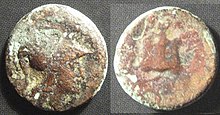 A bronze coin of Side, 350-300 BC: obverse, a Cortinthian-helmeted bust of Athena; reverse, a pomegranate fruit
A bronze coin of Side, 350-300 BC: obverse, a Cortinthian-helmeted bust of Athena; reverse, a pomegranate fruitA pomegranate is displayed on coins from Side. The ancient Greek city of Side was in Pamphylia, a former region on the southern Mediterranean coast of Asia Minor (modern-day Antalya province, Turkey).[65]
Within the Heraion at the mouth of the Sele, near Paestum, Magna Graecia, is a chapel devoted to the Madonna del Granato, “Our Lady of the Pomegranate”, “who by virtue of her epithet and the attribute of a pomegranate must be the Christian successor of the ancient Greek goddess Hera”, observes the excavator of the Heraion of Samos, Helmut Kyrieleis.[66]
 Girl with a Pomegranate, by William-Adolphe Bouguereau, 1875
Girl with a Pomegranate, by William-Adolphe Bouguereau, 1875In modern times, the pomegranate still holds strong symbolic meanings for the Greeks. On important days in the Greek Orthodox calendar, such as the Presentation of the Virgin Mary and on Christmas Day, it is traditional to have at the dinner table polysporia, also known by their ancient name panspermia, in some regions of Greece. In ancient times, they were offered to Demeter[citation needed] and to the other gods for fertile land, for the spirits of the dead and in honor of compassionate Dionysus.[citation needed] When one buys a new home, it is conventional for a house guest to bring as a first gift a pomegranate, which is placed under/near the ikonostasi (home altar) of the house, as a symbol of abundance, fertility, and good luck. Pomegranates are also prominent at modern Greek weddings and funerals.[citation needed] When Greeks commemorate their dead, they make kollyva as offerings, which consist of boiled wheat, mixed with sugar and decorated with pomegranate. It is also traditional in Greece to break a pomegranate on the ground at weddings and on New Years.[citation needed] Pomegranate decorations for the home are very common in Greece and sold in most home goods stores.[67]
Ancient Israel and Judaism[edit]
The pomegranate is mentioned or alluded to in the Bible many times. It is also included in coinage and various types of ancient and modern cultural works.
For example, pomegranates were known in Ancient Israel as the fruits which the scouts brought to Moses to demonstrate the fertility of the “promised land”.[68] The Book of Exodus[69] describes the me’il(“robe of the ephod“) worn by the Hebrewhigh priest as having pomegranates embroidered on the hem, alternating with golden bells which could be heard as the high priest entered and left the Holy of Holies. According to the Books of Kings,[70] the capitals of the two pillars (Jachin and Boaz) that stood in front of Solomon’s Temple in Jerusalem were engraved with pomegranates. Solomon is said to have designed his coronet based on the pomegranate’s “crown” (calyx).[64]
Some Jewish scholars believe the pomegranate was the forbidden fruit in the Garden of Eden.[71] Additionally, pomegranates are one of the Seven Species (Hebrew: שבעת המינים, Shiv’at Ha-Minim) of fruits and grains enumerated in the Hebrew Bible (Deuteronomy 8:8) as special products of the Land of Israel, and the Songs of Solomon contains this quote: “Thy lips are like a thread of scarlet, and thy speech is comely: thy temples are like a piece of a pomegranate within thy locks.” (Song of Solomon 4:3).
It is traditional to consume pomegranates on Rosh Hashana because, with its numerous seeds, it symbolizes fruitfulness.[71] Also, it is said to have 613 seeds, which corresponds with the 613 commandments of the Torah.[72] This particular tradition is referred to in the opening pages of Ursula Dubosarsky‘s novel Theodora’s Gift.[73]
The pomegranate appeared on the ancient coins of Judea, and when not in use, the handles of Torah scrolls are sometimes covered with decorative silver globes similar in shape to “pomegranates” (rimmonim).
Pomegranates symbolize the mystical experience in the Jewish mystical tradition, or kabbalah, with the typical reference being to entering the “garden of pomegranates” or pardes rimonim; this is also the title of a book by the 16th-century mystic Moses ben Jacob Cordovero.
In European Christian motifs[edit]
In the earliest incontrovertible appearance of Christ in a mosaic, a 4th-century floor mosaic from Hinton St Mary, Dorset, now in the British Museum, the bust of Christ and the chi rho are flanked by pomegranates.[74] Pomegranates continue to be a motif often found in Christian religious decoration. They are often woven into the fabric of vestments and liturgical hangings or wrought in metalwork. Pomegranates figure in many religious paintings by the likes of Sandro Botticelli and Leonardo da Vinci, often in the hands of the Virgin Mary or the infant Jesus. The fruit, broken or bursting open, is a symbol of the fullness of Jesus’ suffering and resurrection.[71]
In the Eastern Orthodox Church, pomegranate seeds may be used in kolyva, a dish prepared for memorial services, as a symbol of the sweetness of the heavenly kingdom.
Pakistan[edit]
The pomegranate (known as “anār” انار in Urdu) is a popular fruit in Pakistan. It is grown in Pakistan and is also imported from Afghanistan.
Afghanistan[edit]
Pomegranate, a favored fall and winter fruit in Afghanistan, has mainly two varieties: one that is sweet and dark red with hard seeds growing in and around Kandhar province, and the other that has soft seeds with variable color growing in the central/northern region. The largest market for Afghan pomegranates is Pakistan, followed by India.[75]
Armenia[edit]
The pomegranate is one of the main fruits in Armenian culture (alongside apricots and grapes). Its juice is famously used with Armenian food, heritage, or wine. The pomegranate is the symbol of Armenia and represents fertility, abundance, marriage. It is also a semi-religious icon.[76][77] For example, the fruit played an integral role in a wedding custom widely practiced in ancient Armenia: a bride was given a pomegranate fruit, which she threw against a wall, breaking it into pieces. Scattered pomegranate seeds ensured the bride future children.
The Color of Pomegranates, a movie directed by Sergei Parajanov, is a biography of the Armenian ashugSayat-Nova (King of Song) which attempts to reveal the poet’s life visually and poetically rather than literally.[78]
Azerbaijan[edit]
Pomegranate is considered one of the symbols of Azerbaijan.[79] Annually in October, a cultural festival is held in Goychay, Azerbaijan known as the Goychay Pomegranate Festival. The festival features Azerbaijani fruit-cuisine mainly the pomegranates from Goychay, which is famous for its pomegranate growing industry. At the festival, a parade is held with traditional Azerbaijani dances and Azerbaijani music.[80] Pomegranate was depicted on the official logo of the 2015 European Games held in Azerbaijan.[81] Nar the Pomegranate was one of the two mascots of these games.[82] Pomegranates were also featured on the jackets worn by Azerbaijani male athletes at the games’ opening ceremony.[83]
Bangladesh[edit]
The pomegranate is known as “dalim” and “bedana”in Bengali as well as “anar” and a popular fruit in Bangladesh. People of Bangladesh use it as a very nutritive fruits.
China[edit]
Introduced to China during the Tang Dynasty (618-907 AD), the pomegranate (Chinese: 石榴; pinyin: shíliu) in olden times was considered an emblem of fertility and numerous progeny. This symbolism is a pun on the Chinese character 子 (zǐ) which, as well as meaning seed, also means “offspring” thus a fruit containing so many seeds is a sign of fecundity. Pictures of the ripe fruit with the seeds bursting forth were often hung in homes to bestow fertility and bless the dwelling with numerous offspring, an important facet of traditional Chinese culture.[84]Iran and ancient Persia[edit]
Iran is the second largest producer and largest exporter of pomegranates in the world. The fruit’s juice and paste have a role in Iranian cuisine, e.g. chicken, ghormas, and refreshment bars. Pomegranate skins may be used to stain wool and silk in the carpet industry.[85]
The Pomegranate Festival is an annual cultural and artistic festival held during October in Tehran,[citation needed] to exhibit and sell pomegranates, food products, and handicrafts.
India[edit]
In some Hindu traditions, the pomegranate (Hindi: anār) symbolizes prosperity and fertility, and is associated with both Bhoomidevi (the earth goddess) and Lord Ganesha (the one fond of the many-seeded fruit).[86][87]
[h7416] רִמּוֹן rimmôwn, rim-mone’; or רִמֹּן rimmôn; 32 in 25 pomegranate
- from H7426;
- a pomegranate, the tree (from its upright growth) or the fruit (also an artificial ornament):
- —pomegranate.
Exodus 28:
(33) And [beneath] upon the hem of it thou shalt make pomegranates[H7416] [of] blue, and [of] purple, and [of] scarlet, round about the hem thereof; and bells of gold between them round about: (34) A golden bell and a pomegranate,[H7416] a golden bell and a pomegranate,[H7416] upon the hem of the robe round about.
Exodus 39:
(24) And they made upon the hems of the robe pomegranates[H7416] [of] blue, and purple, and scarlet, [and] twined [linen]. (25) And they made bells [of] pure gold, and put the bells between the pomegranates[H7416] upon the hem of the robe, round about between the pomegranates;[H7416] (26) A bell and a pomegranate,[H7416] a bell and a pomegranate,[H7416] round about the hem of the robe to minister [in]; as the LORD commanded Moses.
Numbers 13:
(23) And they came unto the brook of Eshcol, and cut down from thence a branch with one cluster of grapes, and they bare it between two upon a staff; and [they brought] of the pomegranates,[H7416] and of the figs.
Numbers 20:
(5) And wherefore have ye made us to come up out of Egypt, to bring us in unto this evil place? it [is] no place of seed, or of figs, or of vines, or of pomegranates;[H7416] neither [is] there any water to drink.
Deuteronomy 8:
(8) A land of wheat, and barley, and vines, and fig trees, and pomegranates;[H7416] a land of oil olive, and honey;
1 Samuel 14:
(2) And Saul tarried in the uttermost part of Gibeah under a pomegranate tree[H7416] which [is] in Migron: and the people that [were] with him [were] about six hundred men;
1 Kings 7:
(18) And he made the pillars, and two rows round about upon the one network, to cover the chapiters that [were] upon the top, with pomegranates:[H7416] and so did he for the other chapiter. … (20) And the chapiters upon the two pillars [had pomegranates] also above, over against the belly which [was] by the network: and the pomegranates[H7416] [were] two hundred in rows round about upon the other chapiter. … (42) And four hundred pomegranates[H7416] for the two networks, [even] two rows of pomegranates[H7416] for one network, to cover the two bowls of the chapiters that [were] upon the pillars;
2 Kings 25:
(17) The height of the one pillar [was] eighteen cubits, and the chapiter upon it [was] brass: and the height of the chapiter three cubits; and the wreathen work, and pomegranates[H7416] upon the chapiter round about, all of brass: and like unto these had the second pillar with wreathen work.
2 Chronicles 3:
(16) And he made chains, [as] in the oracle, and put [them] on the heads of the pillars; and made an hundred pomegranates,[H7416] and put [them] on the chains.
2 Chronicles 4:
(13) And four hundred pomegranates[H7416] on the two wreaths; two rows of pomegranates[H7416] on each wreath, to cover the two pommels of the chapiters which [were] upon the pillars.
Song of Songs 4:
(3) Thy lips [are] like a thread of scarlet, and thy speech [is] comely: thy temples [are] like a piece of a pomegranate[H7416] within thy locks. … (13) Thy plants [are] an orchard of pomegranates,[H7416] with pleasant fruits; camphire, with spikenard,
Song of Songs 6:
(7) As a piece of a pomegranate[H7416] [are] thy temples within thy locks. … (11) I went down into the garden of nuts to see the fruits of the valley, [and] to see whether the vine flourished, [and] the pomegranates[H7416] budded.
Song of Songs 7:
(12) Let us get up early to the vineyards; let us see if the vine flourish, [whether] the tender grape appear, [and] the pomegranates[H7416] bud forth: there will I give thee my loves.
Song of Songs 8:
(2) I would lead thee, [and] bring thee into my mother’s house, [who] would instruct me: I would cause thee to drink of spiced wine of the juice of my pomegranate.[H7416]
Jeremiah 52:
(22) And a chapiter of brass [was] upon it; and the height of one chapiter [was] five cubits, with network and pomegranates[H7416] upon the chapiters round about, all [of] brass. The second pillar also and the pomegranates[H7416] [were] like unto these. (23) And there were ninety and six pomegranates[H7416] on a side; [and] all the pomegranates[H7416] upon the network [were] an hundred round about.
Joel 1:
(12) The vine is dried up, and the fig tree languisheth; the pomegranate[H7416] tree, the palm tree also, and the apple tree, [even] all the trees of the field, are withered: because joy is withered away from the sons of men.
Haggai 2:
(19) Is the seed yet in the barn? yea, as yet the vine, and the fig tree, and the pomegranate,[H7416] and the olive tree, hath not brought forth: from this day will I bless [you].
- Dan (The Goat) :: Flood of Serpent :: The Beast :: Judgemnt
- PINES (Cone Bearers) :: CEDARS :: FIRS :: CYPRESS
